Your front yard serves as your home's first impression, setting the tone for the entire property. A well-designed front landscape not only enhances curb appeal but also reflects your personal style and increases property value. Whether you prefer modern minimalism, cottage charm, or drought-tolerant designs, countless possibilities exist to transform your outdoor space. From incorporating native plants and hardscaping elements to creating seasonal interest with layered plantings, successful front yard landscaping combines functionality with aesthetic appeal. The key lies in selecting cohesive design themes that complement your home's architecture while considering your climate, maintenance preferences, and lifestyle needs for a truly stunning outdoor welcome.
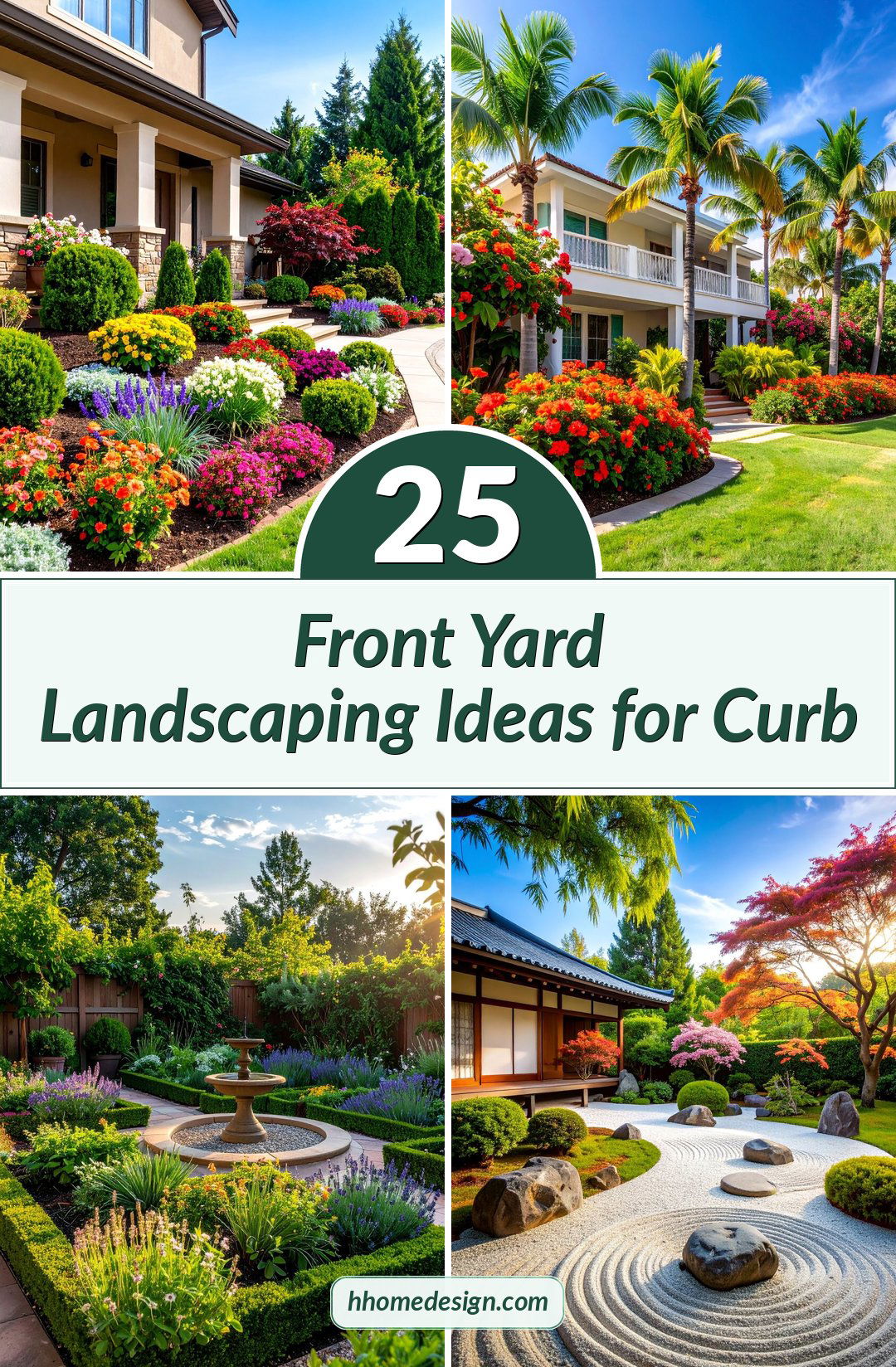
1. Modern Minimalist Front Yard with Geometric Elements
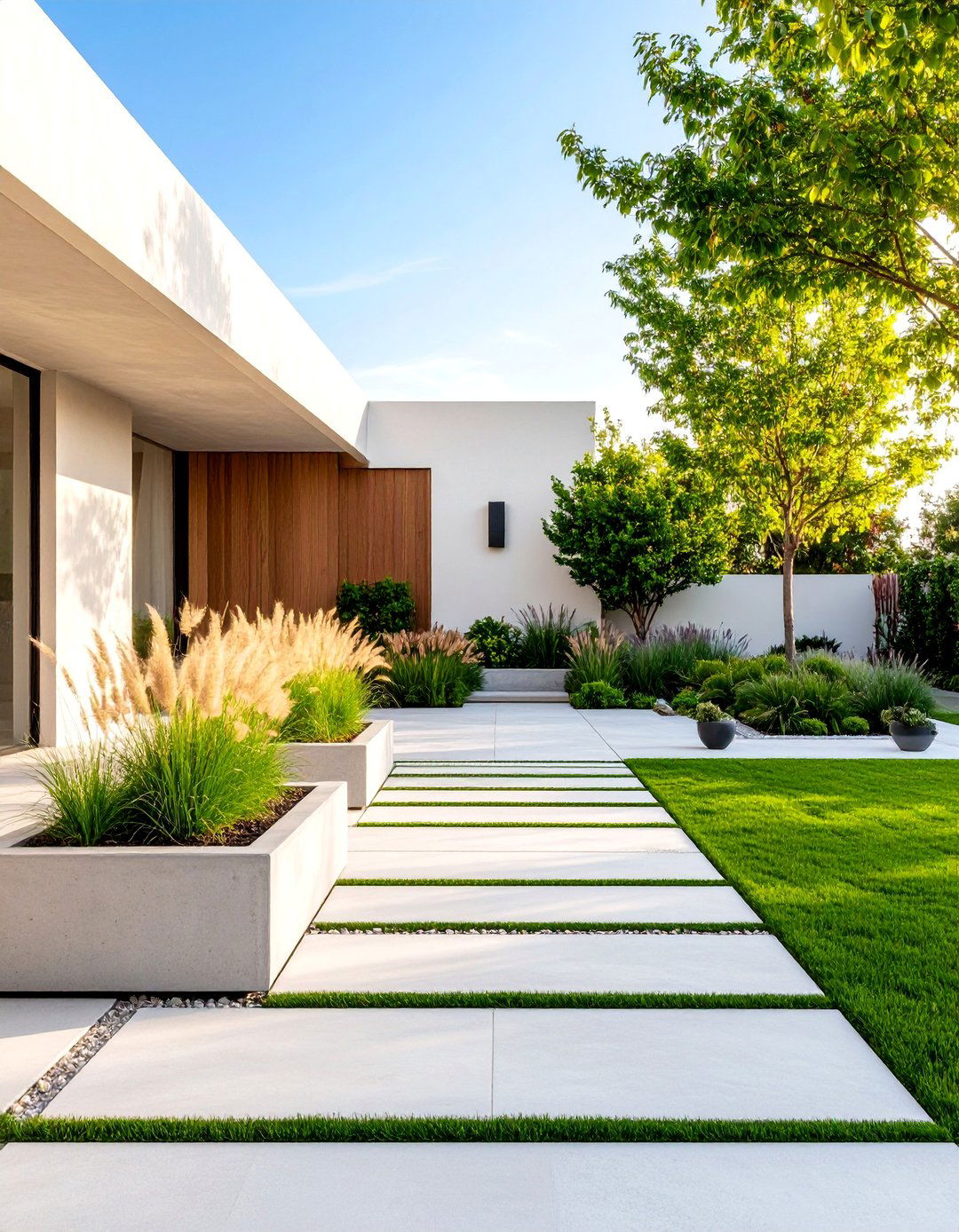
Clean lines and geometric shapes define this contemporary landscaping approach that emphasizes simplicity over complexity. Large rectangular planters filled with structural plants like ornamental grasses or boxwood create striking focal points against neutral hardscaping materials. Concrete pavers arranged in linear patterns lead visitors along defined pathways, while gravel beds replace traditional lawns for low-maintenance appeal. The color palette remains intentionally limited, featuring whites, grays, and deep greens that complement modern architecture. Strategic lighting highlights key elements during evening hours, and water features with clean edges add tranquil sounds without visual clutter. This design philosophy celebrates restraint while creating maximum impact through careful placement of every element.
2. English Cottage Garden Front Yard with Layered Plantings
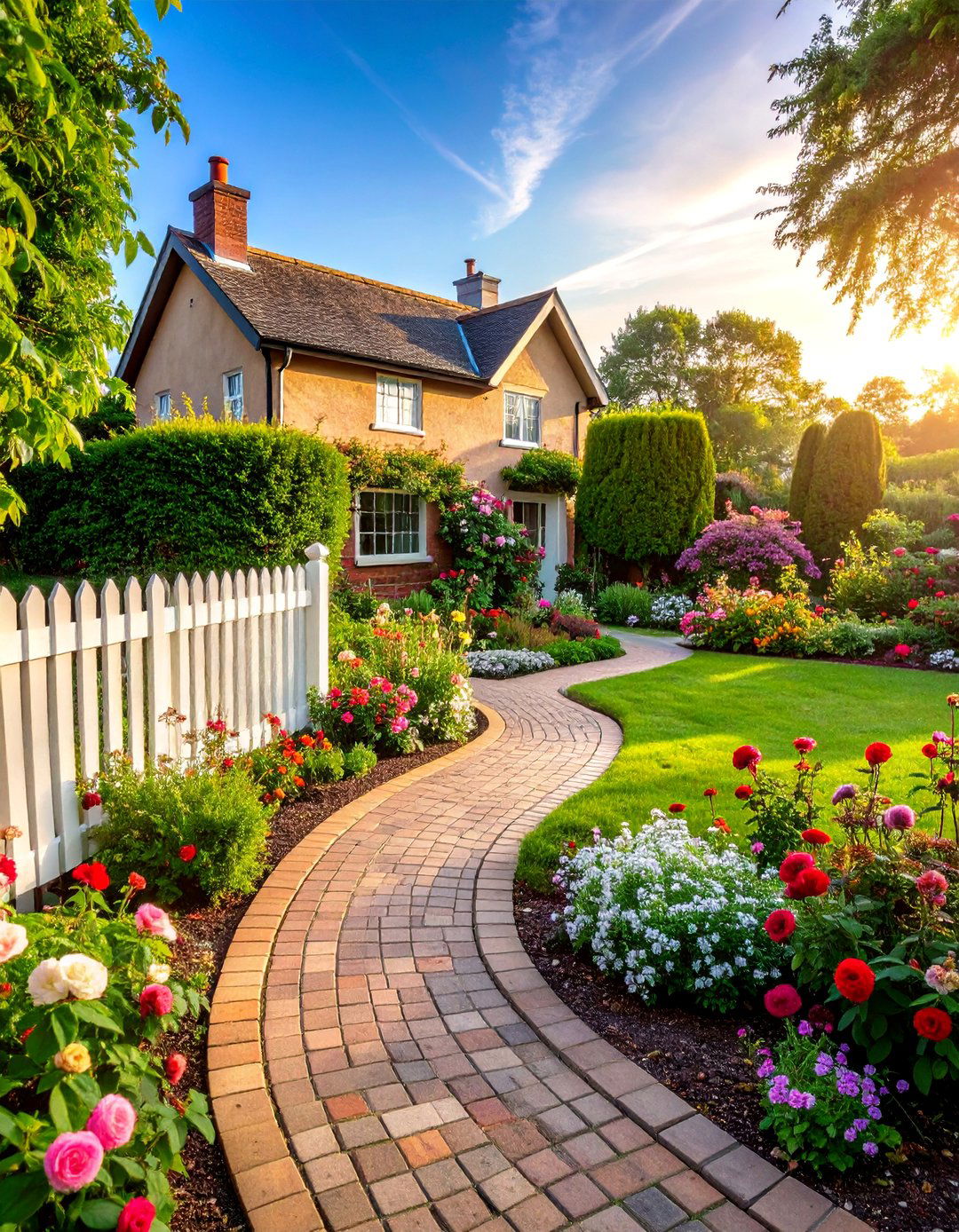
Overflowing with colorful blooms and fragrant herbs, this romantic style creates an informal yet carefully planned landscape that appears naturally evolved. Mixed perennials like foxgloves, delphiniums, and roses intermingle with climbing vines that cascade over fences and arbors. A curved brick pathway meanders through densely planted beds where vegetables grow alongside ornamental flowers, creating practical beauty. White picket fencing provides structure while supporting climbing roses and clematis that bloom throughout seasons. Weathered garden ornaments, vintage containers, and rustic benches add charm and functionality. The key to this style lies in generous plantings that blur boundaries between formal and wild, creating a welcoming haven that invites exploration and discovery.
3. Desert Xeriscaping with Drought-Tolerant Succulents
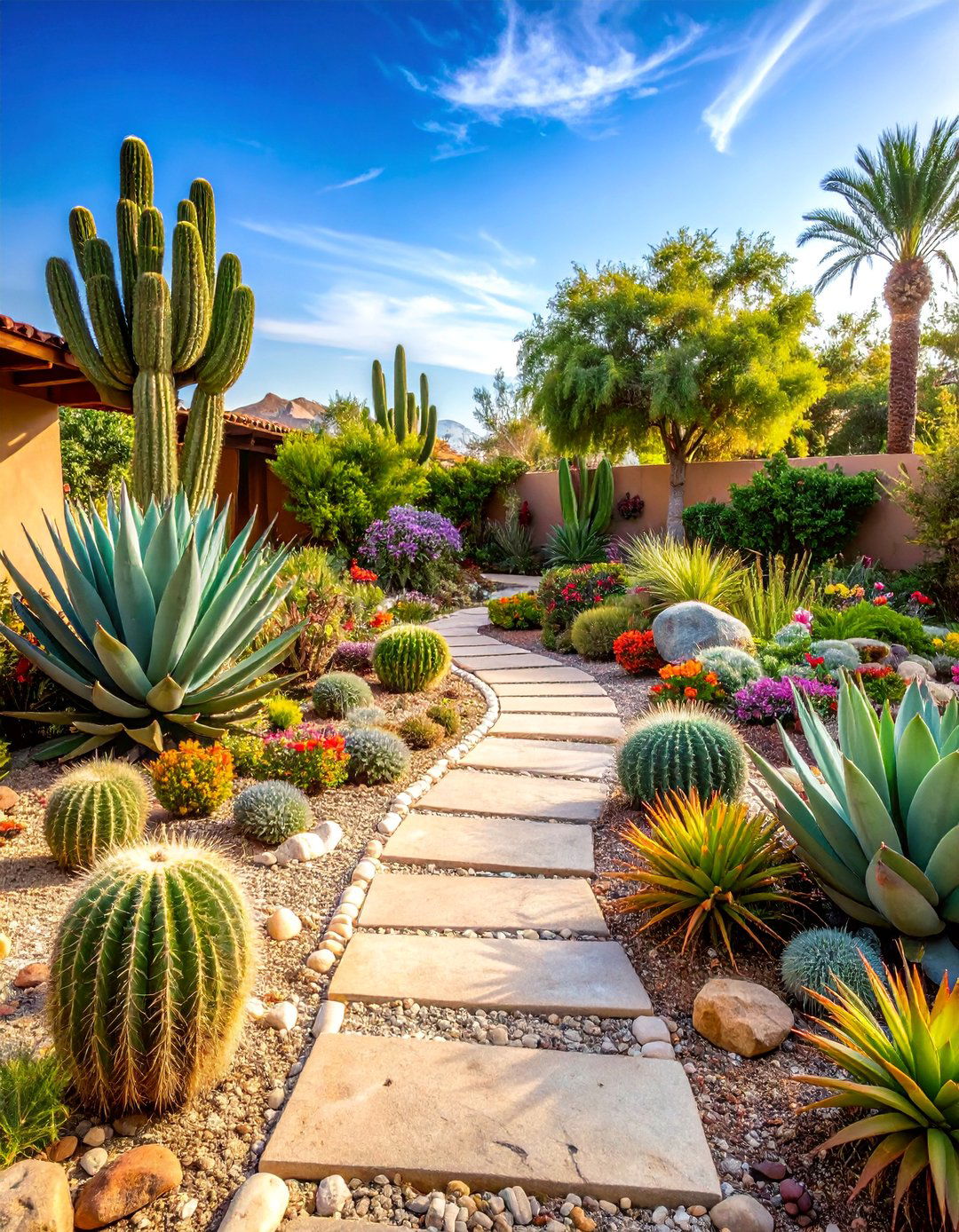
Water-wise landscaping transforms arid environments into stunning displays using native and adapted plants that thrive with minimal irrigation. Sculptural agaves, barrel cacti, and colorful sedums create dramatic texture variations while requiring virtually no supplemental watering once established. Decomposed granite pathways wind between rock gardens featuring different sized boulders that add visual weight and natural beauty. Mediterranean plants like lavender and rosemary provide fragrance and attract pollinators while maintaining drought tolerance. Gravel mulches in varying colors and sizes suppress weeds while conserving soil moisture. Strategic placement of shade trees creates comfortable microclimates, and drip irrigation systems deliver water efficiently to plant root zones when needed, making this sustainable approach both environmentally responsible and visually striking.
4. Traditional Foundation Planting with Evergreen Structure
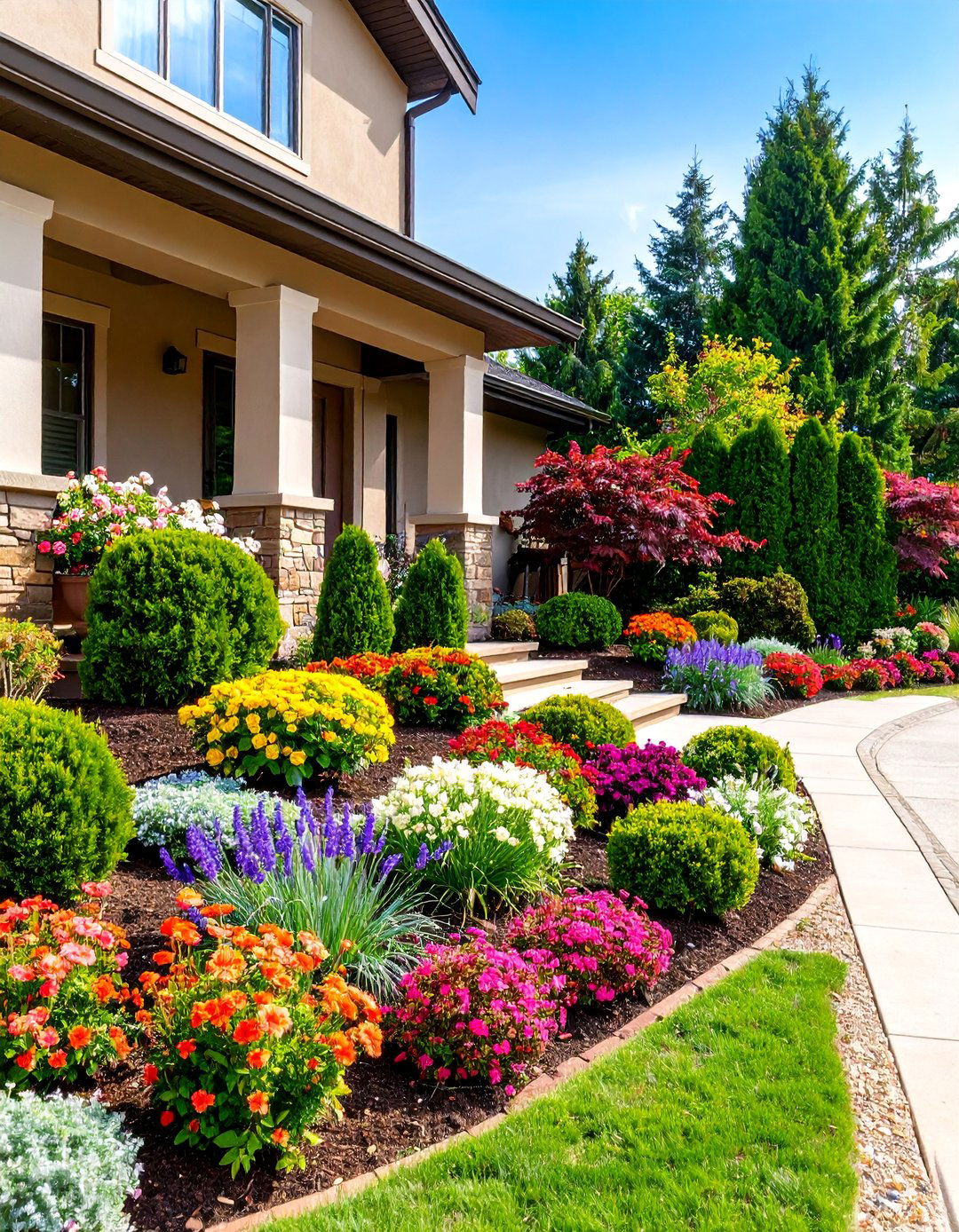
Classic foundation plantings provide year-round structure while enhancing your home's architectural features through careful plant selection and placement. Evergreen shrubs like boxwood, holly, and dwarf conifers create permanent backbone plantings that look attractive in all seasons. Layered heights progress from tall background shrubs to medium-sized flowering plants and low-growing groundcovers that soften hard edges. Seasonal color comes from carefully chosen perennials and annuals that complement rather than compete with structural elements. Mulched beds with defined edges create neat, well-maintained appearances that increase property values. This timeless approach works with various architectural styles, from colonial to contemporary, providing reliable beauty that requires moderate maintenance while delivering consistent curb appeal through changing seasons and weather conditions.
5. Japanese-Inspired Zen Garden with Stone Elements
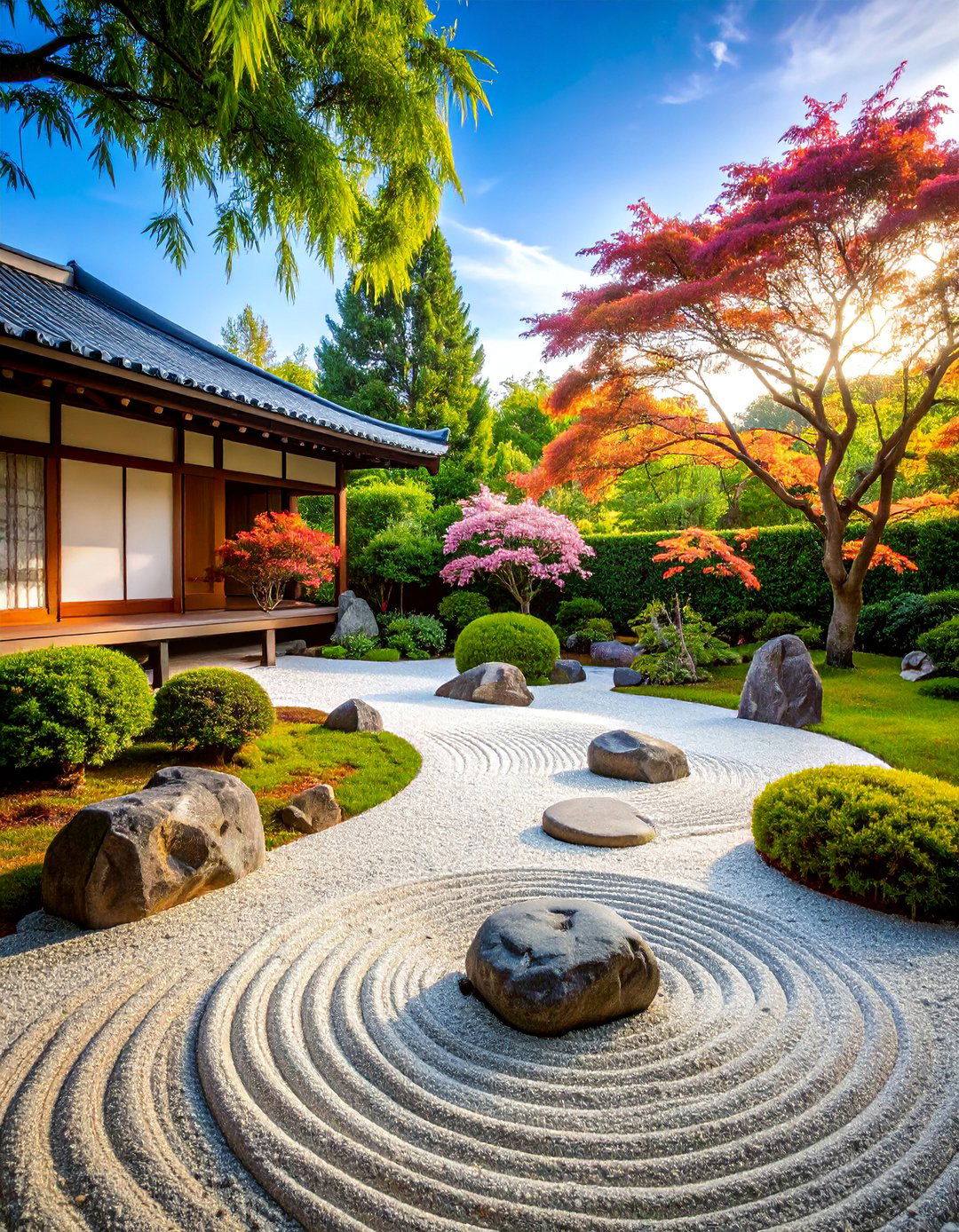
Peaceful tranquility characterizes this design philosophy that emphasizes balance, simplicity, and natural materials to create meditative outdoor spaces. Carefully selected stones in various sizes create focal points and define different areas, while gravel raked in flowing patterns represents water movement. Architectural plants like Japanese maples, bamboo, and ornamental grasses provide seasonal interest without overwhelming the serene atmosphere. Simple wooden elements such as gates, benches, or bridges add functional beauty while maintaining the understated aesthetic. Water features like stone basins or small streams introduce gentle sounds that enhance the calming environment. Moss-covered surfaces and carefully controlled plant selections ensure this style remains uncluttered and contemplative, offering homeowners a peaceful retreat from busy daily life.
6. Mediterranean Courtyard Style with Terra Cotta Accents

Warm, inviting landscapes inspired by Mediterranean climates feature drought-tolerant plants and natural materials that create resort-like atmospheres. Terra cotta containers filled with herbs like rosemary, thyme, and oregano provide both culinary value and aromatic appeal throughout the outdoor space. Olive trees, lavender, and ornamental grasses thrive in sunny conditions while requiring minimal water inputs once established. Natural stone or clay tile pathways connect different areas, and low walls create intimate spaces for seating and relaxation. Climbing vines like bougainvillea or jasmine add vertical interest and seasonal color to walls and pergolas. The overall effect combines functionality with relaxed elegance, creating outdoor living spaces that encourage gatherings and outdoor dining while celebrating natural beauty and sustainable gardening practices.
7. Victorian Formal Garden with Symmetrical Design
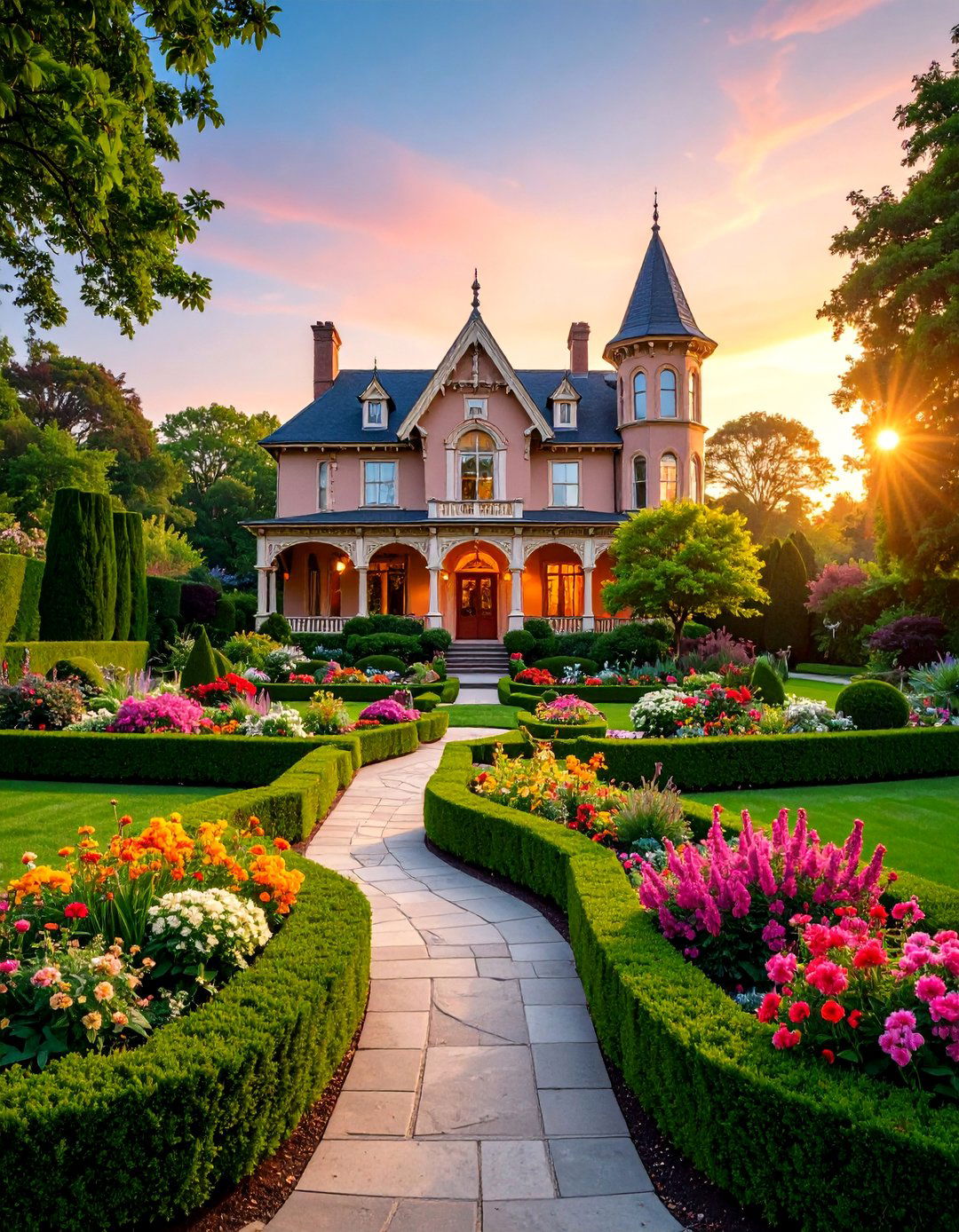
Elegant symmetry and precise planning characterize this classic approach that emphasizes order, balance, and refined plant selections. Matching plantings on either side of central pathways create formal axes that draw attention to focal points like fountains or specimen trees. Boxwood hedges define planting beds and create geometric patterns that remain attractive throughout all seasons. Colorful annuals planted in precise patterns provide seasonal displays that can be changed to maintain year-round interest. Ornate elements like wrought iron gates, decorative urns, and classical statuary add period-appropriate details that enhance the sophisticated atmosphere. This high-maintenance style requires regular pruning and careful plant care but rewards homeowners with impressive displays that complement Victorian, Georgian, or Colonial Revival architecture while creating grand first impressions.
8. Prairie Wildflower Garden with Native Grasses
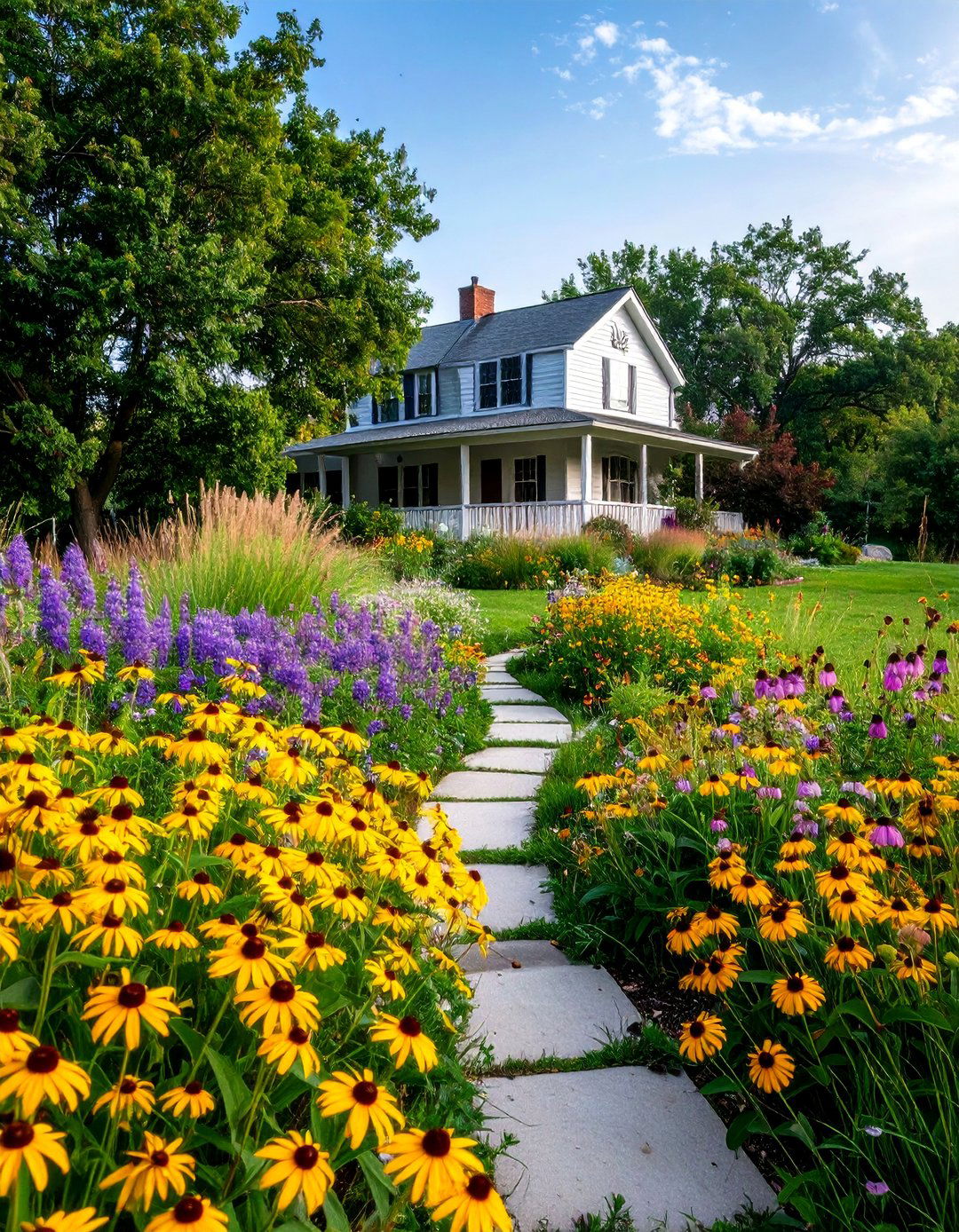
Natural beauty unfolds through this sustainable approach that celebrates regional plant communities while providing habitat for local wildlife. Native wildflowers like black-eyed Susans, purple coneflowers, and blanket flowers create colorful displays that change throughout growing seasons. Ornamental grasses such as little bluestem and buffalo grass provide structure and movement while requiring minimal maintenance once established. Meandering pathways encourage exploration while allowing close observation of seasonal changes and wildlife activity. This low-maintenance style supports pollinators, birds, and beneficial insects while reducing water consumption and chemical inputs. The naturalistic appearance may appear casual, but careful planning ensures continuous blooms and attractive compositions. Regional adaptation means plants thrive without extensive care, making this environmentally responsible choice both beautiful and practical for homeowners seeking sustainable landscaping solutions.
9. Tropical Paradise Front Yard with Palm Trees
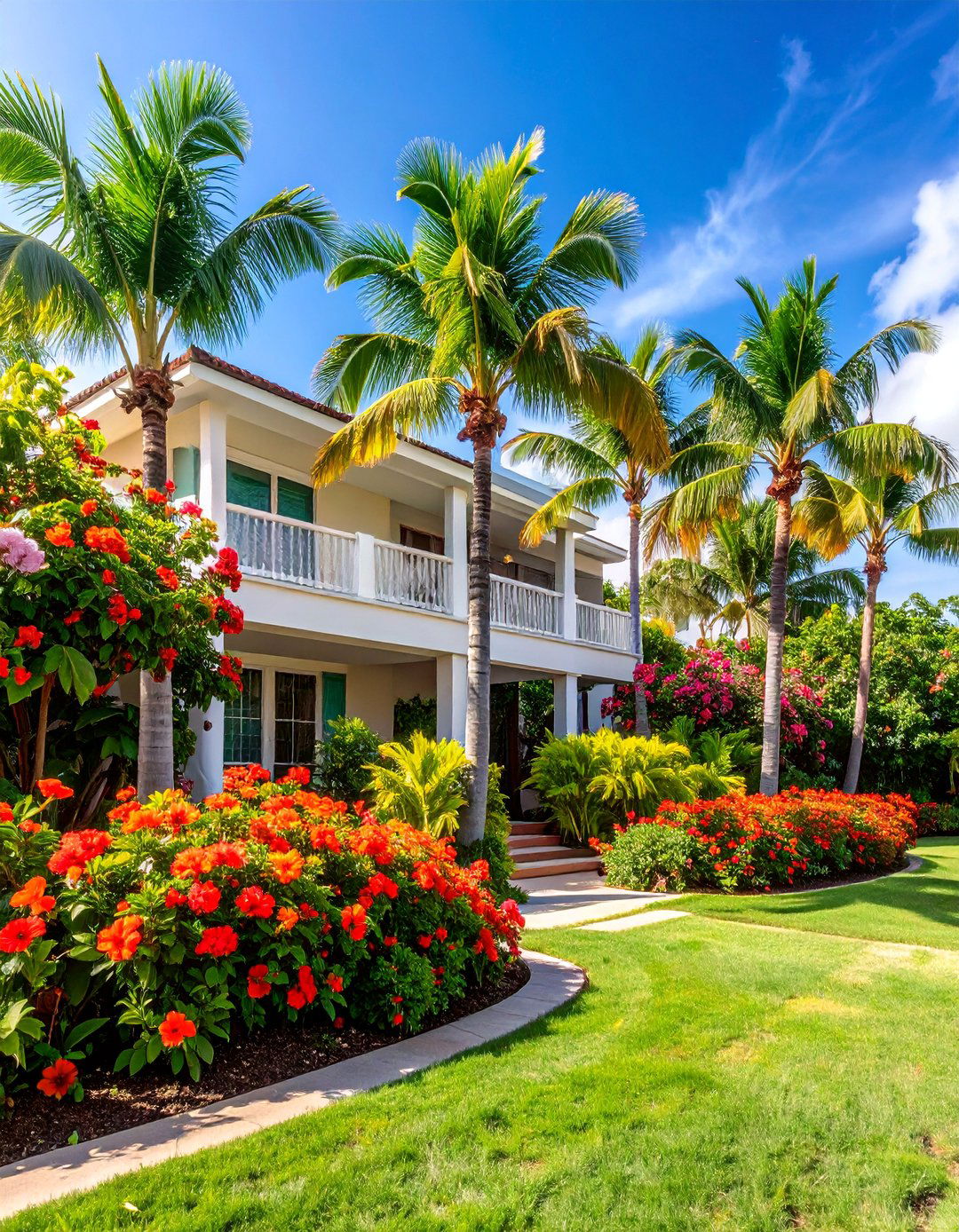
Lush, exotic plantings create vacation-like atmospheres using tropical and subtropical plants that transform ordinary spaces into extraordinary retreats. Palm trees provide vertical elements and tropical character while broad-leafed plants like bird of paradise and elephant ears add dramatic foliage textures. Colorful flowering plants such as hibiscus, bougainvillea, and plumeria provide continuous blooms in warm climates. Natural materials like bamboo, teak, and stone create pathways and accents that complement the tropical theme. Water features enhance the resort atmosphere while supporting the higher humidity needs of tropical plants. Strategic lighting illuminates key features for evening enjoyment, and container plantings allow seasonal adjustments. This high-impact style requires consistent watering and protection from cold temperatures but creates stunning displays that transport homeowners to tropical destinations.
10. Rustic Farmhouse Style with Split Rail Fencing
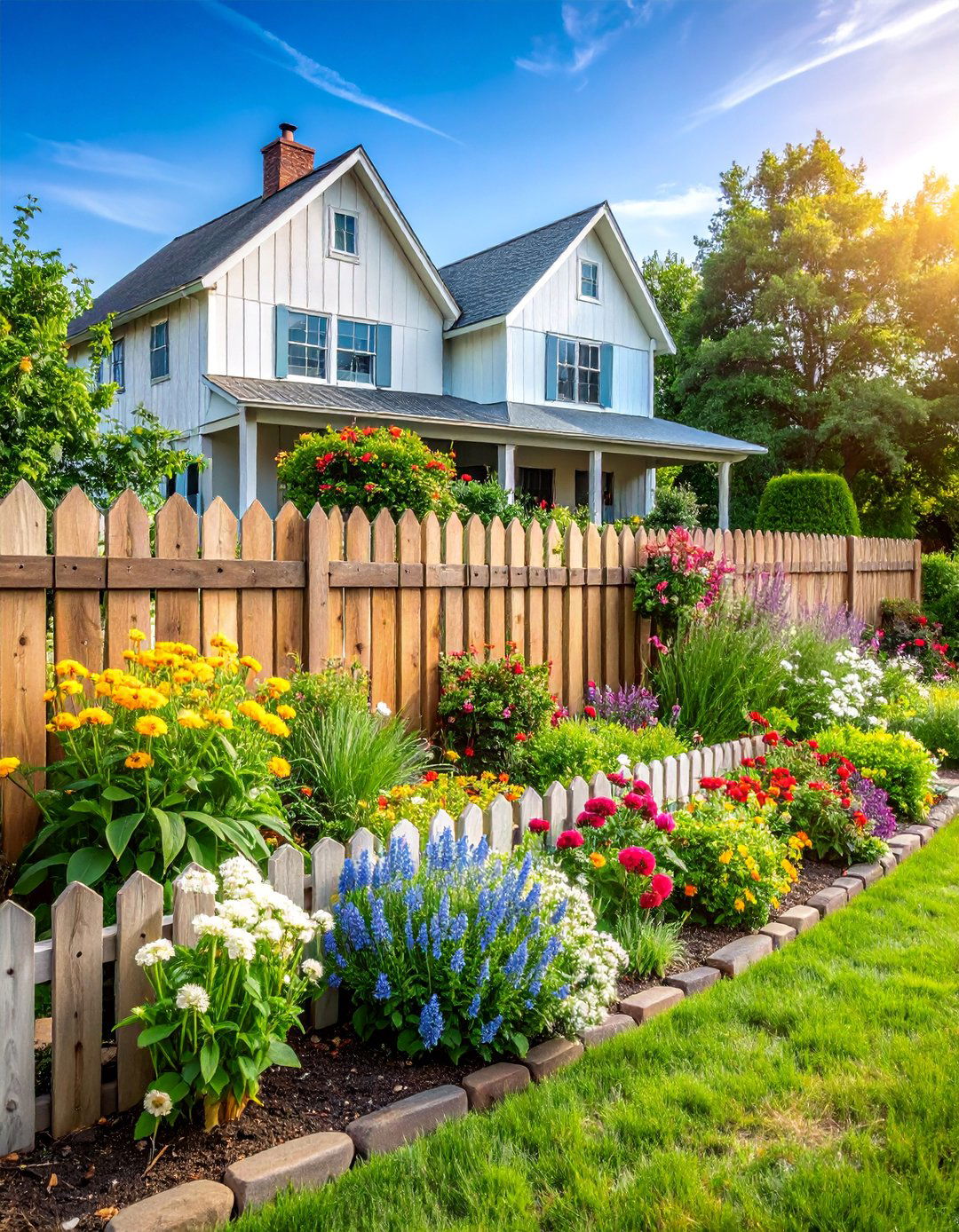
Casual, countryside charm characterizes this approachable style that combines practical elements with comfortable, lived-in beauty. Split rail or picket fencing defines property boundaries while supporting climbing roses, morning glories, or vegetable vines that add vertical interest. Mixed plantings include both ornamental and edible plants, blending flower borders with herb gardens and small fruit trees. Natural materials like weathered wood, stone, and gravel create pathways and structures that age gracefully over time. Vintage containers, old wheelbarrows, and repurposed items add character while serving functional purposes. This style celebrates imperfection and seasonal changes, requiring moderate maintenance while providing fresh produce and cut flowers. The overall effect feels welcoming and unpretentious, perfect for homeowners who appreciate natural beauty and practical functionality in their outdoor spaces.
11. Contemporary Rock Garden with Architectural Plants
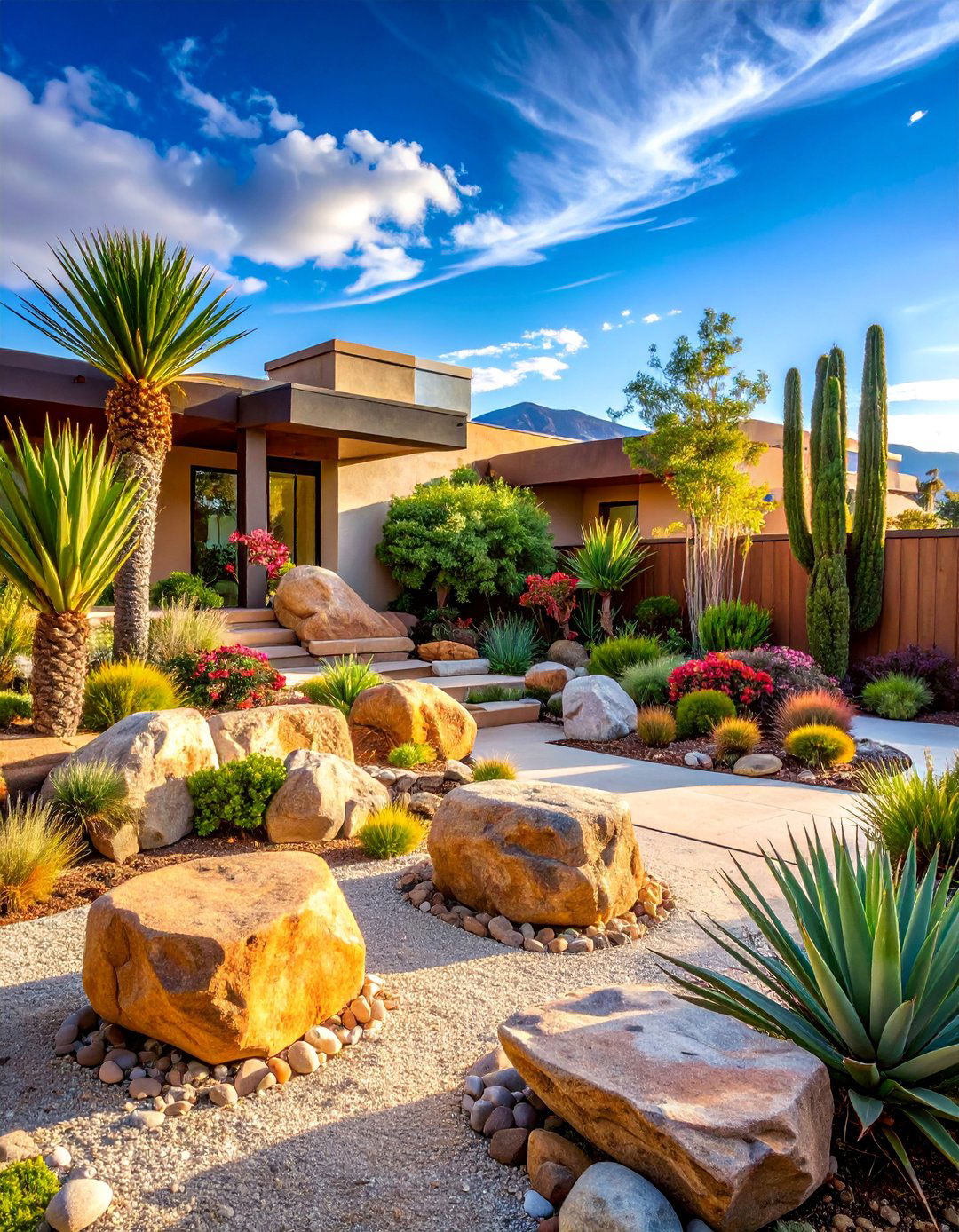
Bold architectural elements and dramatic plant combinations create striking modern landscapes that emphasize texture, form, and color contrast. Large boulders serve as natural sculptures while providing structure and visual weight in strategic locations throughout the design. Spiky plants like yucca, agave, and ornamental grasses create dramatic silhouettes against softer background plantings or neutral hardscaping materials. Modern materials such as corten steel, concrete, and composite decking provide clean lines and contemporary appeal. Strategic lighting highlights key features and creates dramatic shadows during evening hours. Water features with geometric forms add movement and sound while maintaining the modern aesthetic. This low-maintenance approach celebrates the natural beauty of plants and stone while creating sophisticated outdoor spaces that complement contemporary architecture and urban environments.
12. Seasonal Color Garden with Succession Planting
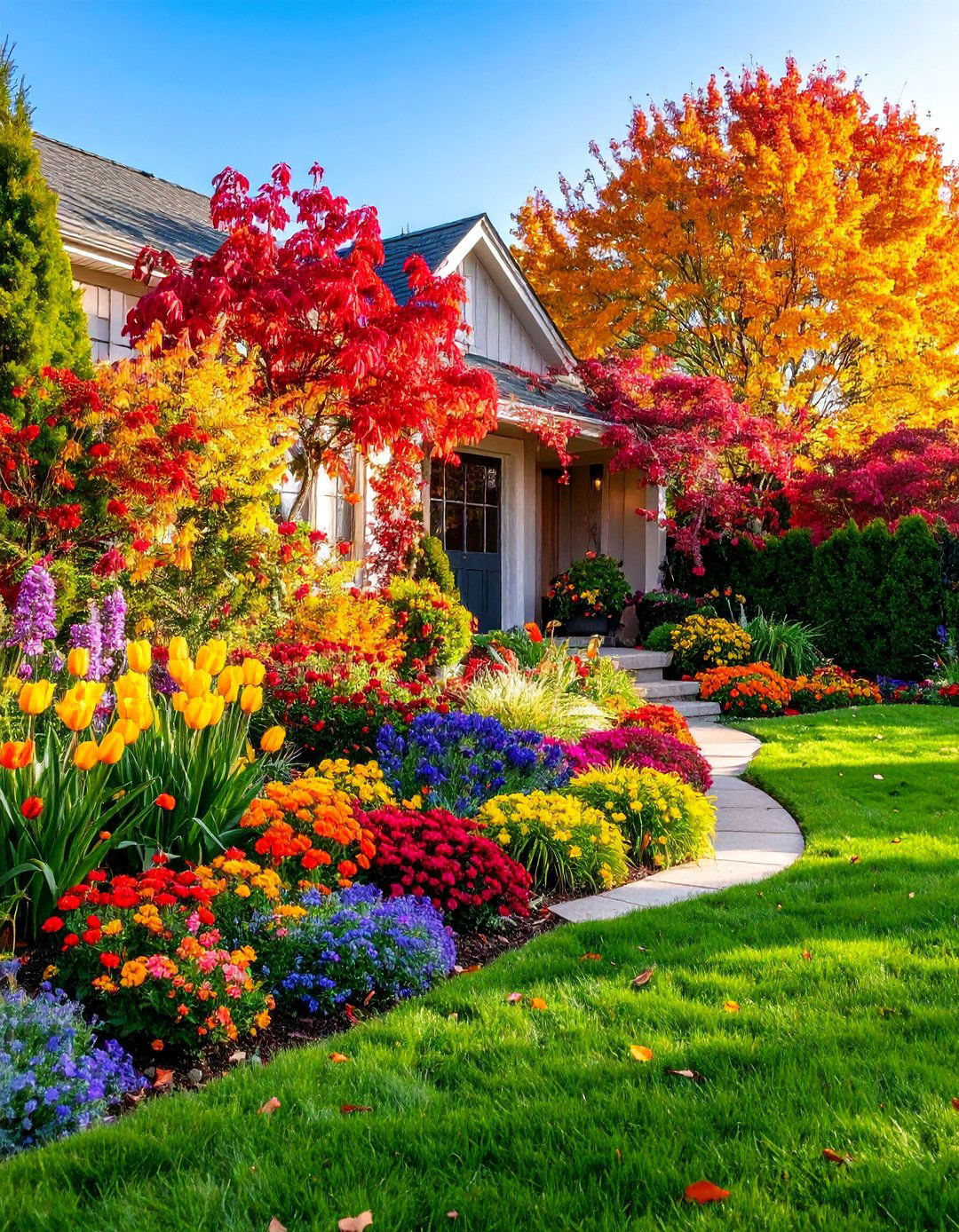
Continuous seasonal interest drives this dynamic approach that ensures attractive displays throughout the entire growing season and beyond. Spring bulbs like tulips and daffodils provide early color, followed by summer perennials such as daylilies and coneflowers. Fall brings colorful foliage from ornamental trees and late-blooming asters, while winter interest comes from evergreen plantings and ornamental grasses with persistent seed heads. Layered planting heights create depth and visual interest, with tall background shrubs, medium perennials, and low groundcovers working together harmoniously. Strategic placement ensures that as one display fades, another reaches peak attractiveness. This approach requires careful planning and moderate maintenance but rewards homeowners with gardens that remain beautiful and interesting throughout all seasons, providing excellent value and continuous enjoyment from landscape investments.
13. Butterfly and Pollinator Garden with Native Plants
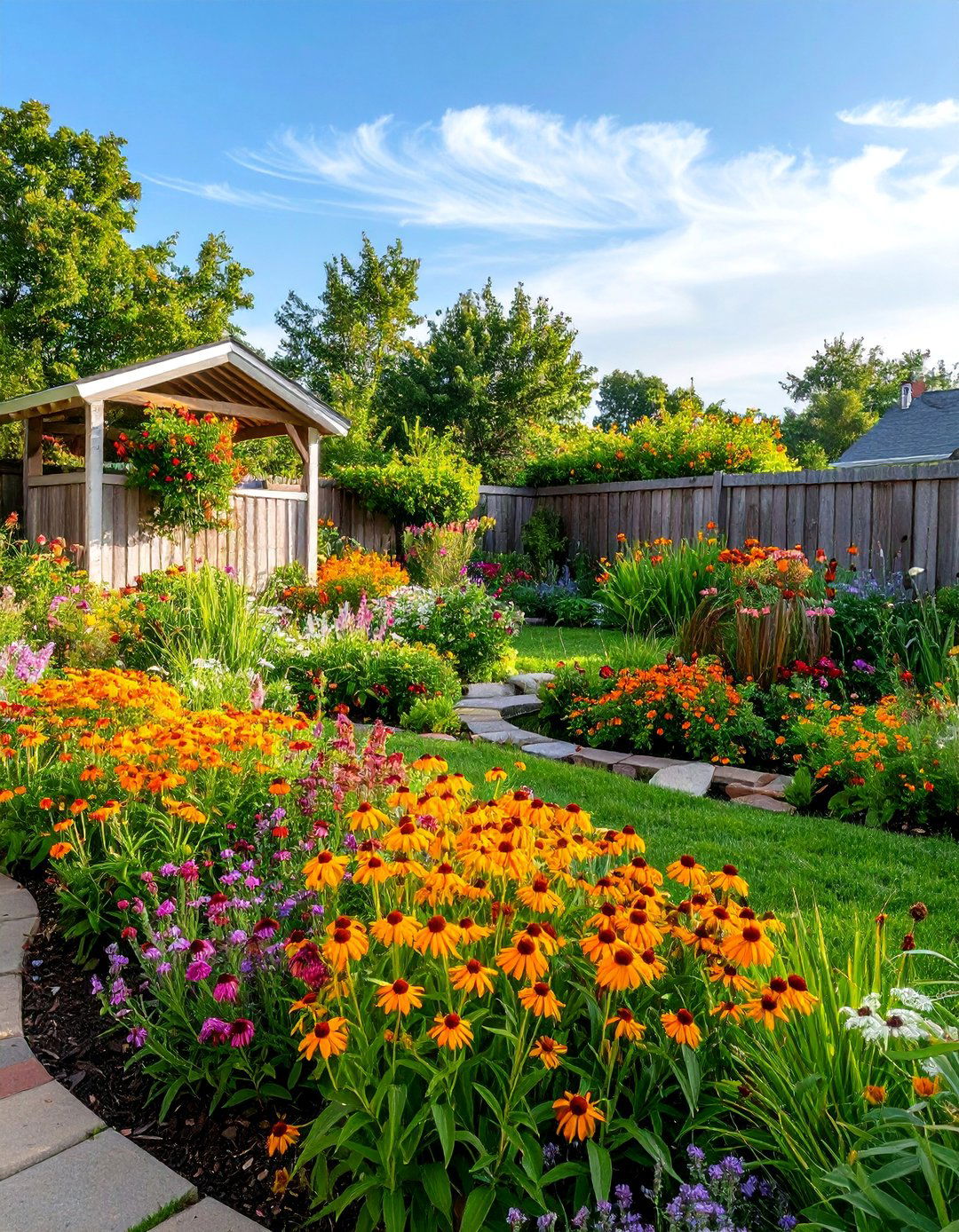
Wildlife-friendly plantings create living ecosystems that support beneficial insects while providing colorful, fragrant displays throughout growing seasons. Native plants like bee balm, butterfly weed, and native asters provide nectar sources that attract butterflies, bees, and hummingbirds. Host plants for butterfly larvae ensure complete life cycles can occur within the garden space. Varied bloom times from spring through fall maintain consistent food sources for pollinators and other beneficial wildlife. Shallow water sources and shelter areas enhance habitat value while organic gardening practices protect beneficial insects from harmful chemicals. This sustainable approach reduces maintenance requirements while creating educational opportunities for families to observe wildlife interactions. The result combines environmental stewardship with beautiful landscaping that changes constantly as different species visit and utilize the garden resources throughout seasons.
14. Shade Garden Oasis with Hostas and Ferns
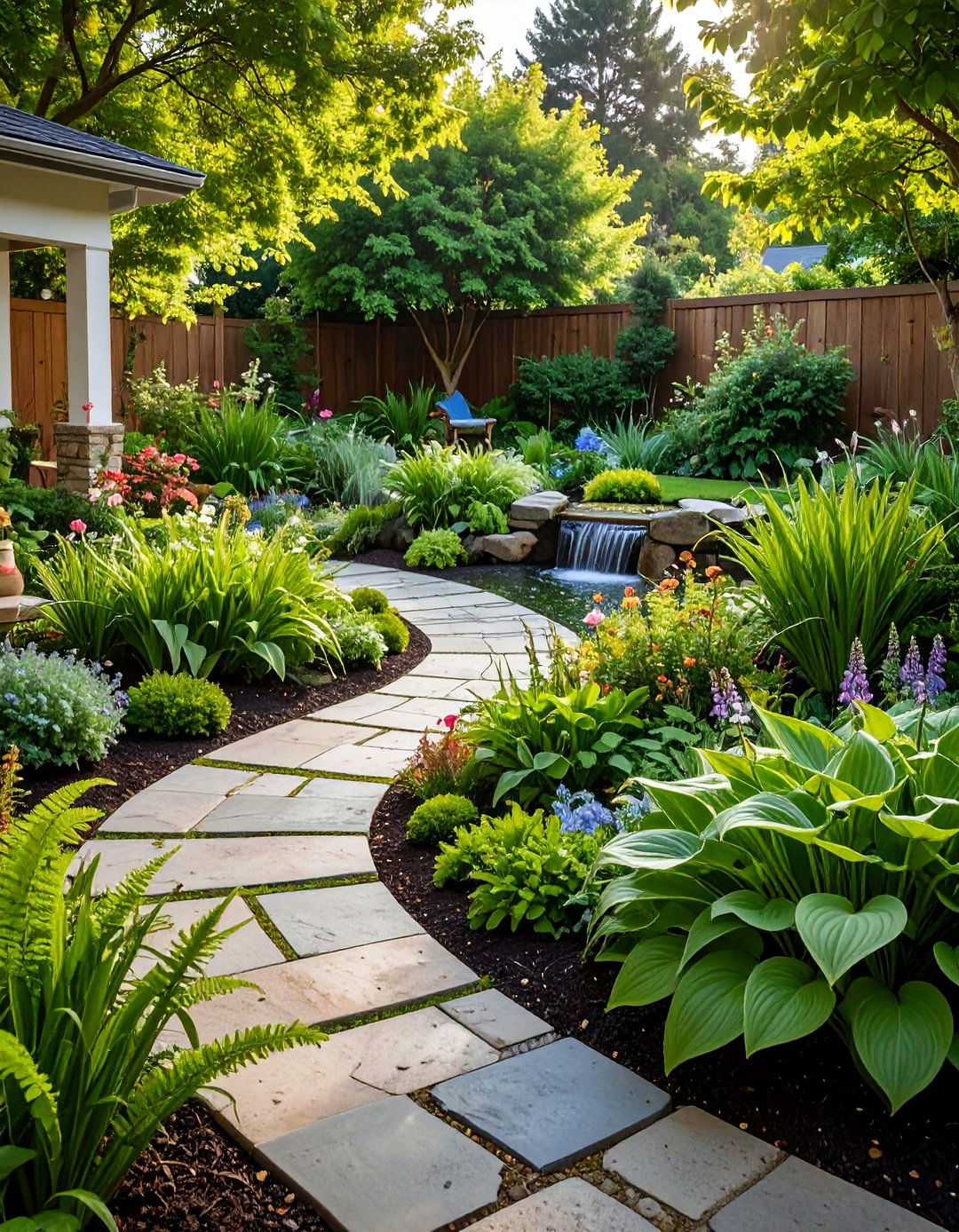
Cool, peaceful retreats emerge in challenging shaded areas through careful selection of plants that thrive in low-light conditions. Hostas in various sizes and leaf patterns provide reliable foliage interest, while ferns add delicate textures and natural woodland appeal. Flowering shade plants like astilbe, coral bells, and caladiums provide seasonal color without requiring direct sunlight. Meandering pathways of flagstone or mulch encourage exploration while protecting delicate plants from foot traffic. Water features such as small fountains or birdbaths enhance the cool, refreshing atmosphere while providing wildlife habitat. Strategic placement of containers allows seasonal plant changes and mobility for optimal growing conditions. This style transforms potentially problematic shaded areas into valuable outdoor living spaces that provide relief from summer heat while creating attractive, low-maintenance landscapes that complement natural woodland settings.
15. Formal Herb Garden with Geometric Layout
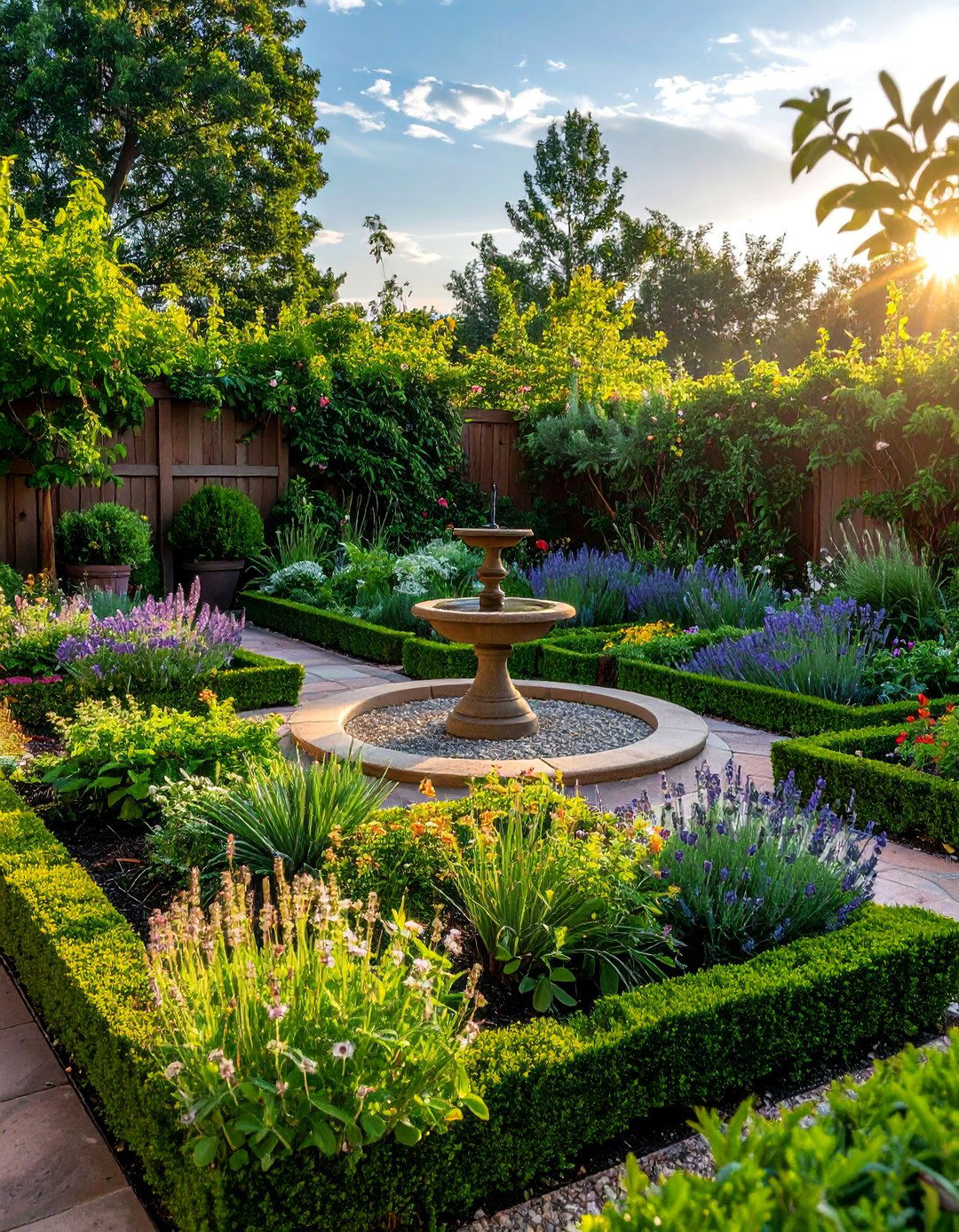
Practical beauty combines culinary functionality with attractive landscaping through organized plantings of useful herbs and aromatic plants. Geometric planting beds defined by low hedges or decorative edging create formal patterns that remain attractive throughout growing seasons. Culinary herbs like basil, rosemary, thyme, and oregano provide fresh ingredients while contributing varied textures, colors, and fragrances to the landscape design. Central focal points such as sundials, birdbaths, or specimen plants anchor the geometric layouts and provide visual interest during seasons when herbs are dormant. Pathways of brick, stone, or gravel allow easy access for harvesting while maintaining the formal appearance. This style combines historical garden traditions with modern convenience, creating beautiful landscapes that serve practical purposes while adding value and charm to properties through organized, attractive plantings.
16. Water Feature Garden with Stream Elements
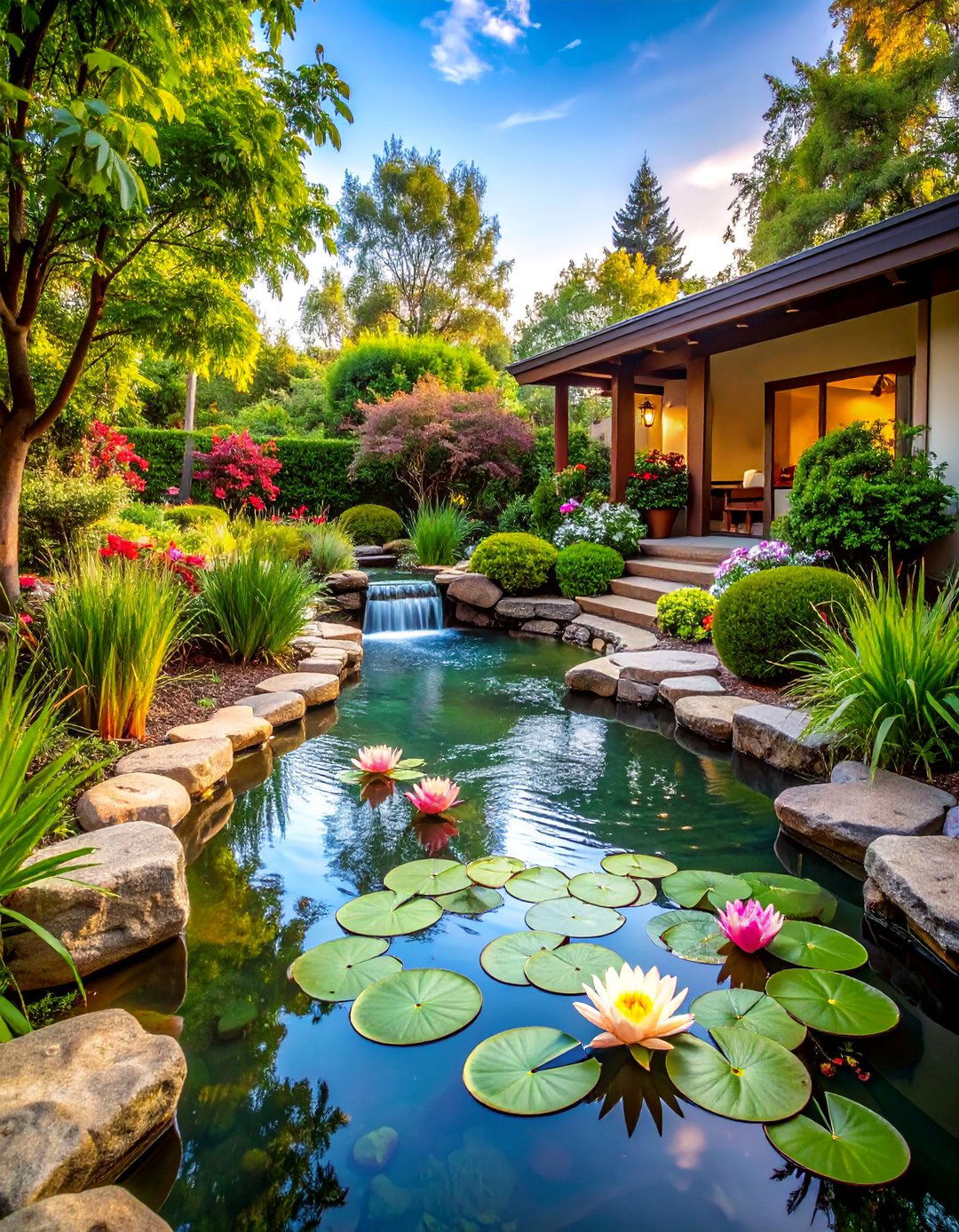
Tranquil water sounds and movement create focal points that enhance any landscaping style while providing relaxing outdoor environments. Natural stone streams wind through planted areas, connecting different elevation levels while creating habitat for wildlife and interesting visual elements. Pond areas with aquatic plants like water lilies and cattails add diversity and natural beauty while supporting beneficial insects and small wildlife. Surrounding plantings of moisture-loving plants such as astilbe, cardinal flower, and ferns create lush displays that complement water features naturally. Recirculating systems conserve water while maintaining consistent flow and preventing stagnation. Strategic lighting illuminates water features for evening enjoyment and creates dramatic reflections. This style requires moderate maintenance and initial investment but provides lasting beauty and increased property values while creating peaceful outdoor retreats that homeowners can enjoy throughout seasons.
17. Cottage Vegetable Garden with Picket Fence Borders
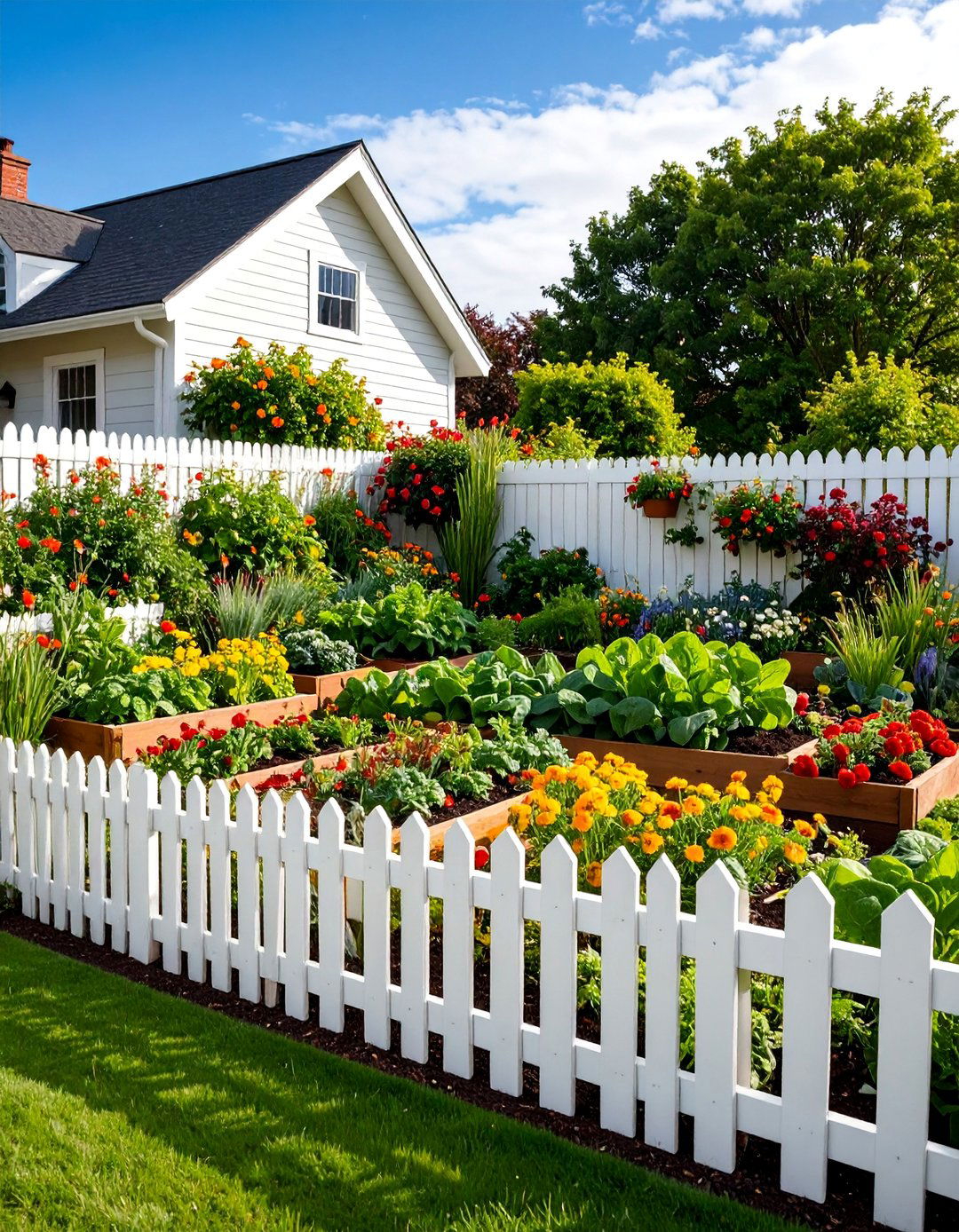
Practical beauty emerges through combining ornamental and edible plants in charming, productive landscapes that serve multiple purposes effectively. White picket fencing provides structure and support for climbing vegetables like beans, peas, and cucumbers while defining garden boundaries attractively. Mixed plantings combine colorful vegetables with herbs and flowers, creating visually appealing compositions that change throughout growing seasons. Raised beds improve drainage and soil quality while making maintenance tasks easier and more comfortable for gardeners. Pathways of brick, stone, or wood chips provide access while protecting soil from compaction during maintenance activities. This style celebrates traditional garden practices while providing fresh produce and cut flowers for household use. The overall effect combines productivity with beauty, creating outdoor spaces that serve practical needs while enhancing property appeal and connecting homeowners with food production traditions.
18. Succulent Display Garden with Gravel Mulching
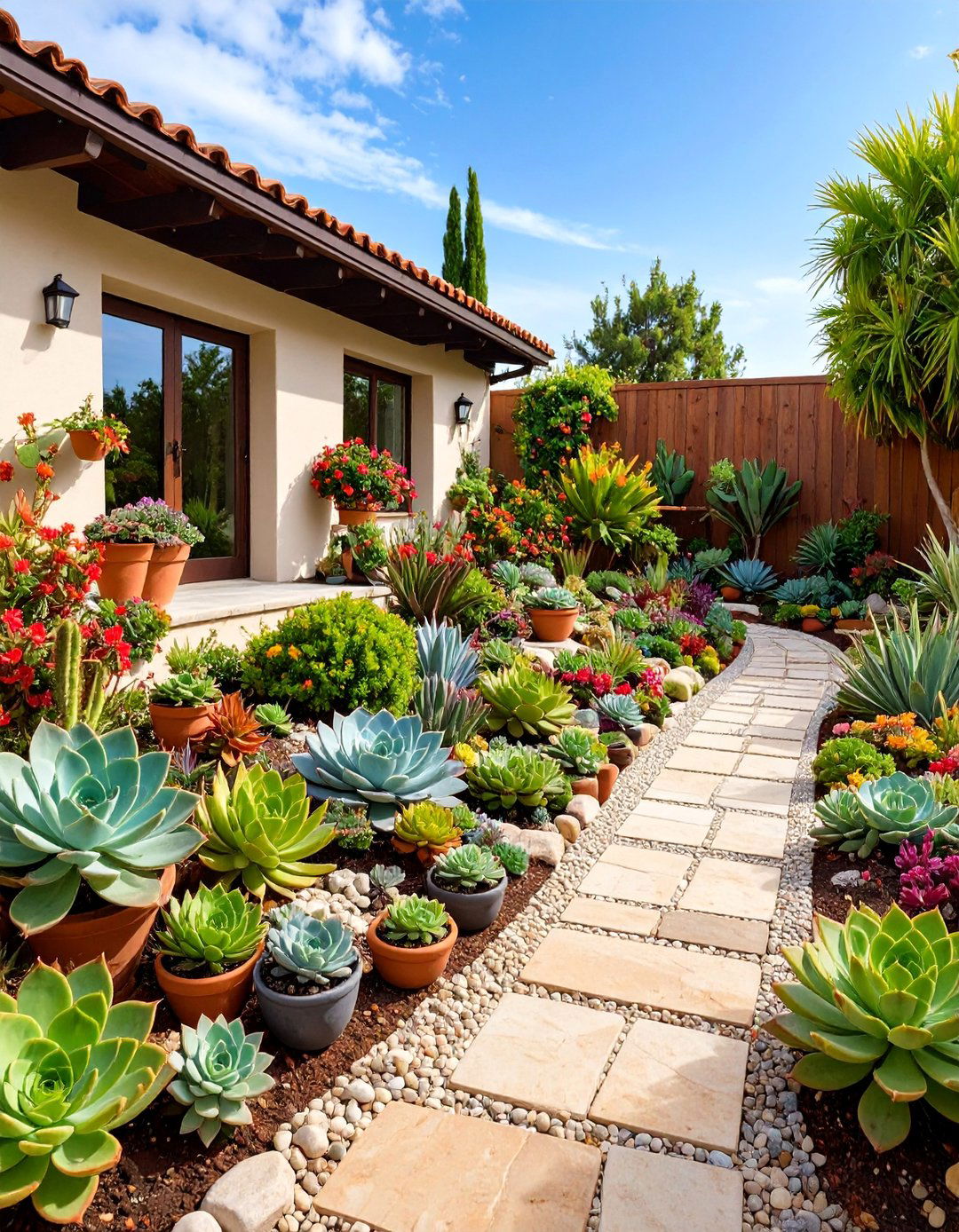
Low-maintenance beauty emerges through creative combinations of drought-tolerant succulents that provide year-round interest with minimal care requirements. Varied succulent species in different sizes, colors, and textures create living sculptures that change subtly with seasons and growing conditions. Gravel mulches in complementary colors suppress weeds while conserving soil moisture and providing attractive backgrounds for plant displays. Container groupings allow mobility and seasonal rearrangements while protecting tender species during extreme weather conditions. Rock gardens and stone pathways provide structure and drainage while complementing the desert-inspired aesthetic naturally. This sustainable approach requires minimal watering once established and thrives in challenging conditions where other plants struggle. Strategic placement creates focal points and transitions between different garden areas while maintaining consistent themes throughout the landscape design, perfect for busy homeowners seeking attractive, low-maintenance solutions.
19. Rose Garden Showcase with Companion Planting
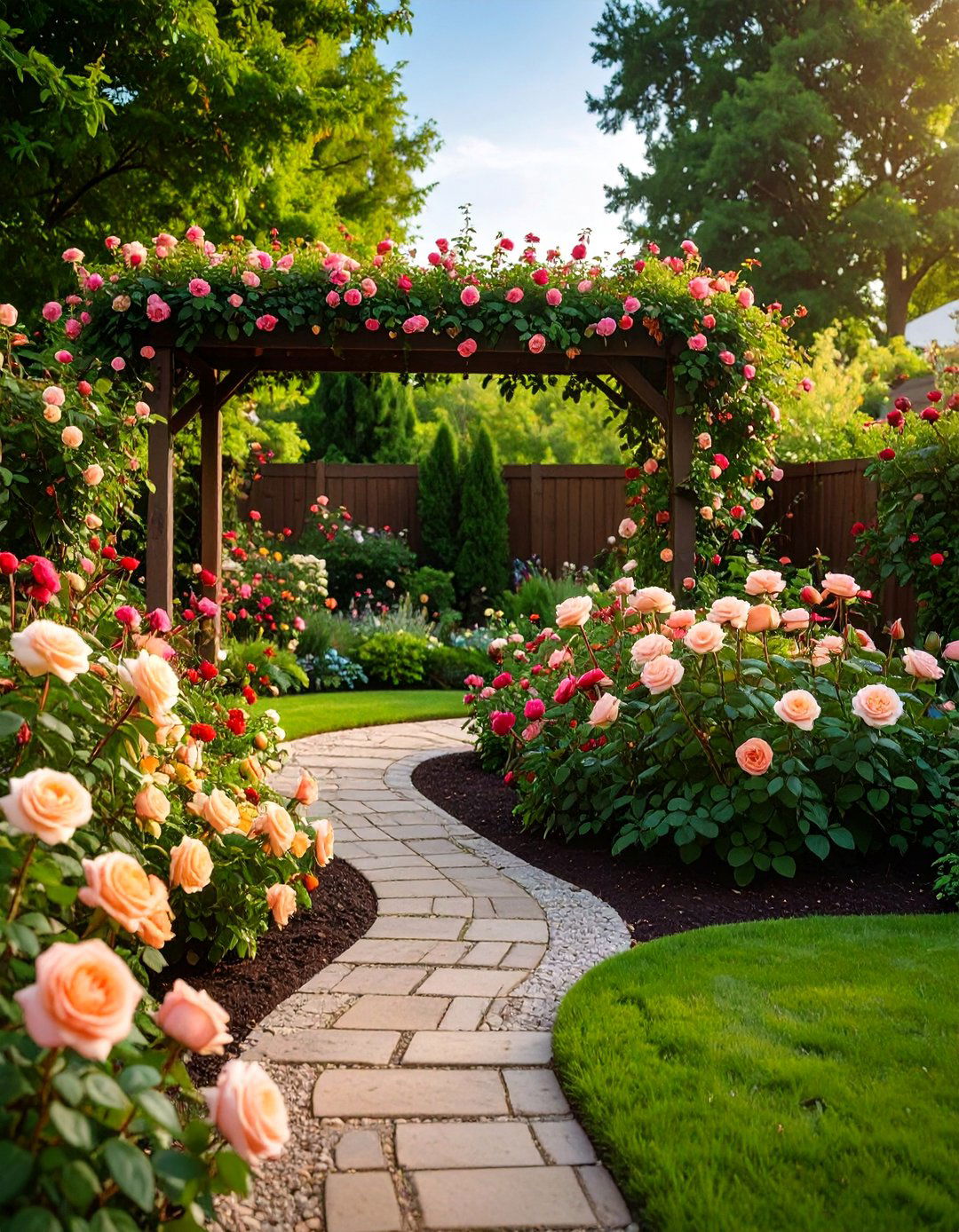
Classic beauty and fragrance define this traditional approach that celebrates roses while incorporating companion plants that enhance both beauty and plant health. Hybrid tea roses, climbing varieties, and shrub roses provide continuous blooms throughout growing seasons when properly maintained and fertilized. Companion plants like lavender, catmint, and alliums help deter pests while adding complementary colors and textures to rose displays. Formal or informal layouts accommodate different architectural styles and personal preferences while ensuring adequate air circulation and sunlight for optimal rose health. Mulched pathways provide access for maintenance while protecting soil and plant roots from compaction damage. This classic style requires regular maintenance including pruning, fertilizing, and disease management but rewards gardeners with spectacular displays and cut flowers. Strategic planning ensures succession of blooms and attractive combinations that enhance property values significantly.
20. Container Garden Showcase with Seasonal Displays
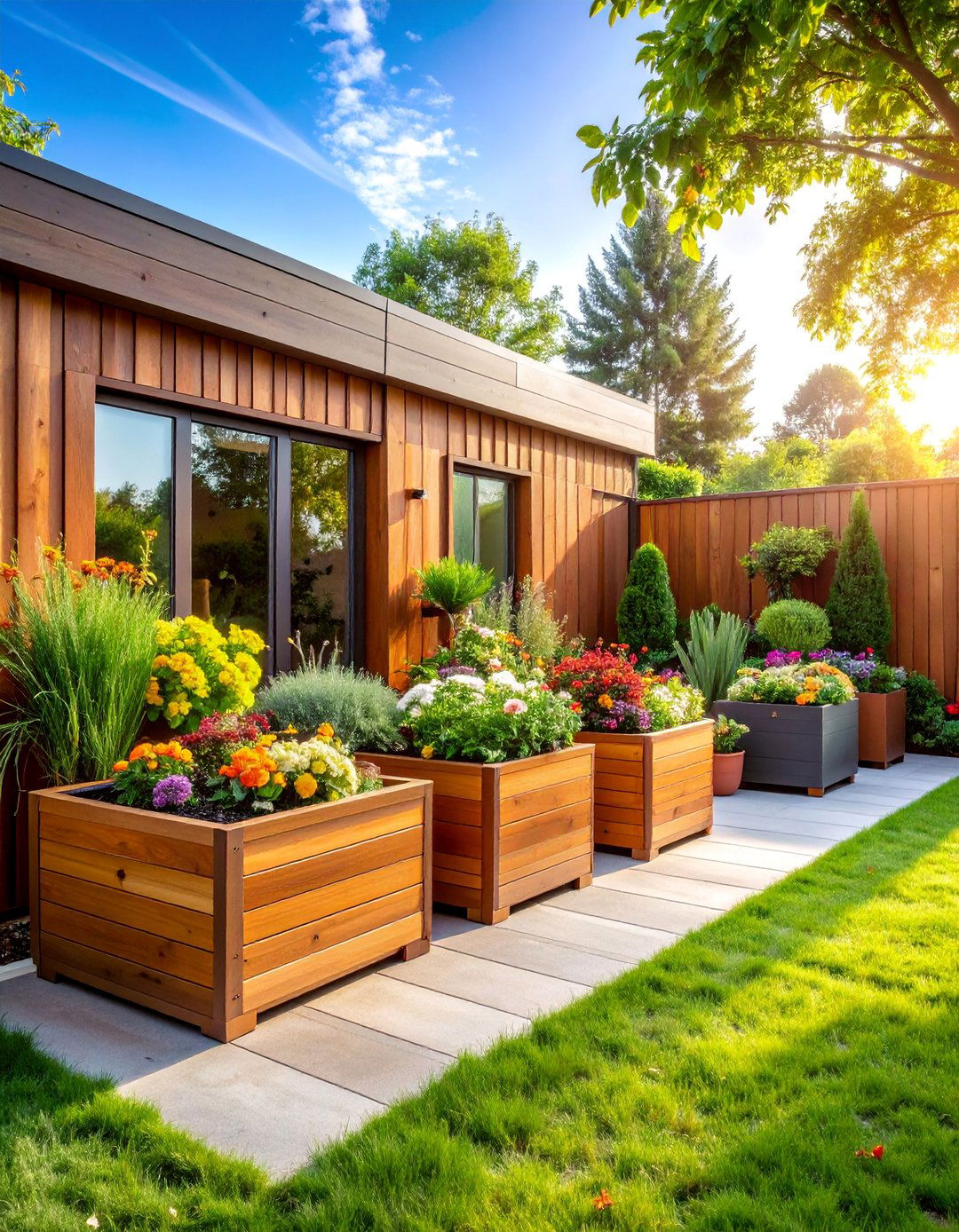
Flexible, manageable plantings utilize containers of various sizes and materials to create attractive displays that adapt to changing seasons and conditions. Large planters anchor entrances and corners while smaller containers provide accents and seasonal color changes throughout the year. Groupings of containers in odd numbers create pleasing compositions while allowing individual plants optimal growing conditions through specialized soil mixtures. Seasonal plantings rotate from spring bulbs to summer annuals to fall displays and winter evergreens, maintaining year-round interest and color. Mobile containers allow rearrangement for parties, seasonal changes, or plant protection during extreme weather conditions. This approach works well for renters, beginners, or homeowners with challenging soil conditions. Container gardens provide opportunities for experimentation with new plants while requiring less commitment than permanent landscape installations, making them perfect for learning and adapting gardening skills.
21. Perennial Border Garden with Mixed Heights
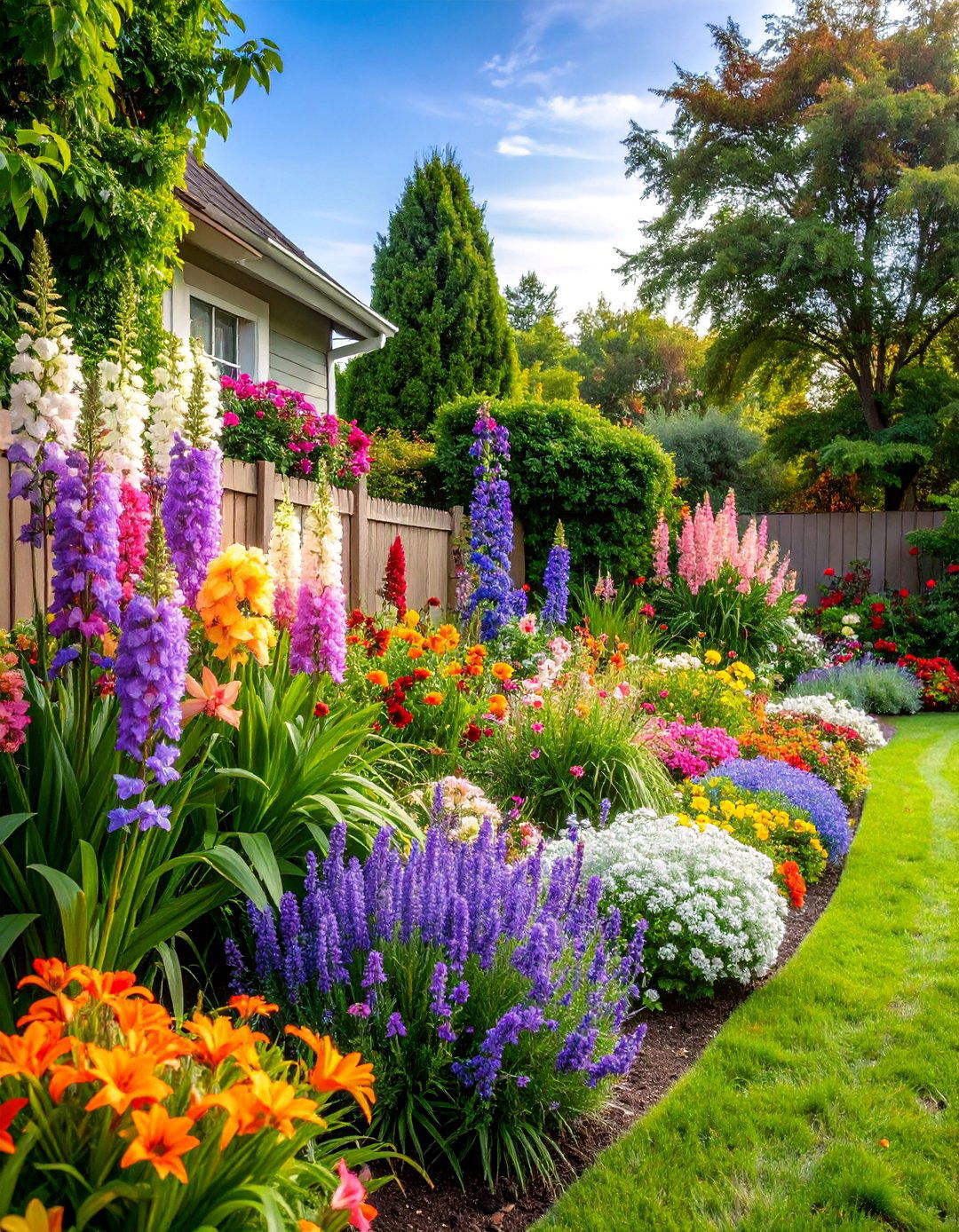
Long-lasting beauty emerges through carefully planned combinations of perennial plants that return reliably each growing season with increasing maturity. Layered heights create depth and visual interest, with tall background plants like delphiniums and hollyhocks providing vertical elements. Medium-height perennials such as daylilies, peonies, and iris create the main display area, while low-growing plants like coral bells and creeping phlox provide ground-level interest. Succession of bloom times ensures continuous color from spring through fall, with complementary foliage textures maintaining appeal during non-blooming periods. Strategic placement of evergreen shrubs provides winter structure and backdrop for perennial displays. This approach requires initial planning and moderate maintenance but increases in beauty and value over time as plants mature and spread naturally. The result provides excellent return on investment while creating spectacular seasonal displays that enhance property values significantly.
22. Ornamental Grass Garden with Natural Movement
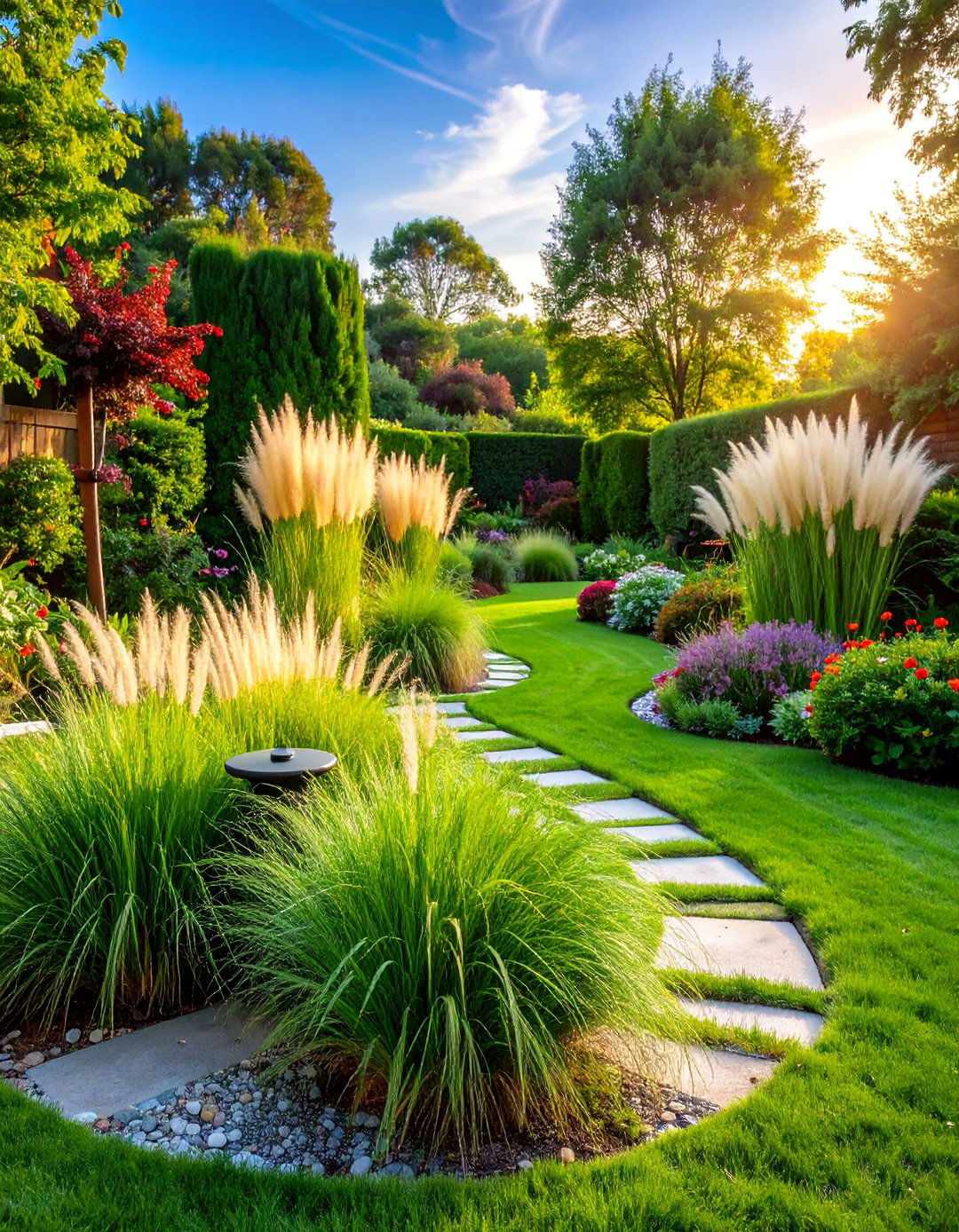
Graceful movement and textural interest characterize this contemporary approach that celebrates the natural beauty of ornamental grasses in landscape settings. Varied grass species provide different heights, colors, and seasonal changes while requiring minimal maintenance once established in appropriate locations. Fountain grass, maiden grass, and blue fescue create soft, flowing elements that contrast beautifully with harder landscape materials like stone and concrete. Seasonal seed heads provide winter interest and wildlife food while maintaining attractive structural elements during dormant seasons. Strategic placement creates natural screens, defines spaces, and adds privacy without formal barriers or extensive maintenance requirements. This sustainable approach works well in challenging conditions including slopes, windy areas, and drought-prone locations. The natural appearance complements both contemporary and traditional architectural styles while providing habitat for beneficial wildlife and requiring minimal inputs for maximum visual impact throughout growing seasons.
23. Edible Landscape Garden with Fruit Trees
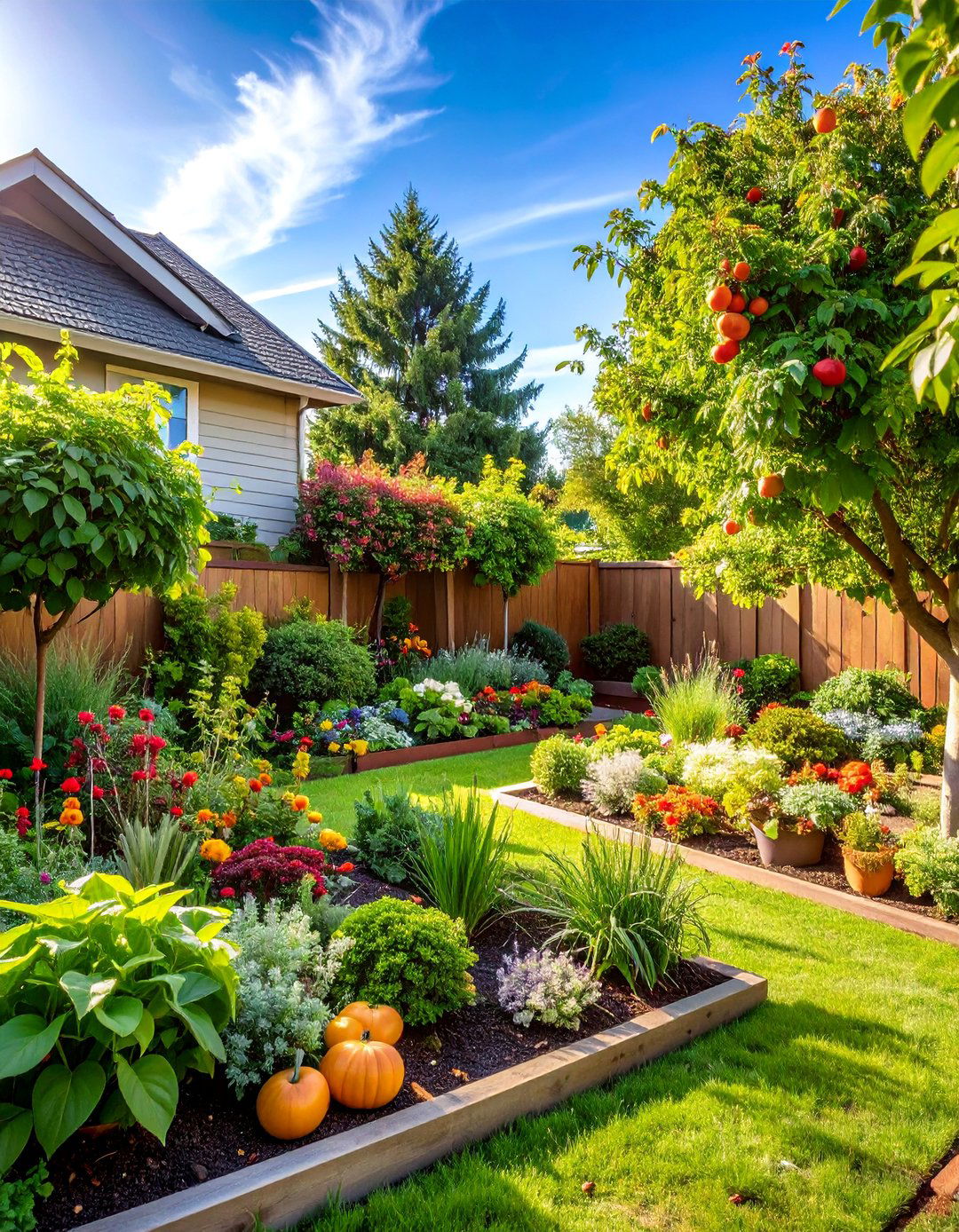
Productive beauty combines food production with attractive landscaping through strategic placement of edible plants that serve multiple purposes effectively. Fruit trees provide vertical elements, seasonal flowers, and fresh produce while creating shade and structure within landscape designs. Berry bushes, herb borders, and vegetable areas integrate seamlessly with ornamental plantings, creating functional beauty that serves practical household needs. Attractive edibles like colorful lettuce, rainbow chard, and flowering herbs blur lines between ornamental and productive gardening approaches. Seasonal changes from spring blossoms to summer fruit to fall foliage provide year-round interest and beauty while supplying fresh food for families. This approach requires knowledge of growing requirements and pest management but provides excellent value through reduced grocery costs and superior flavor quality. Strategic planning ensures attractive compositions while meeting practical needs for fresh, healthy food production in residential settings.
24. Slope Management Garden with Terraced Plantings
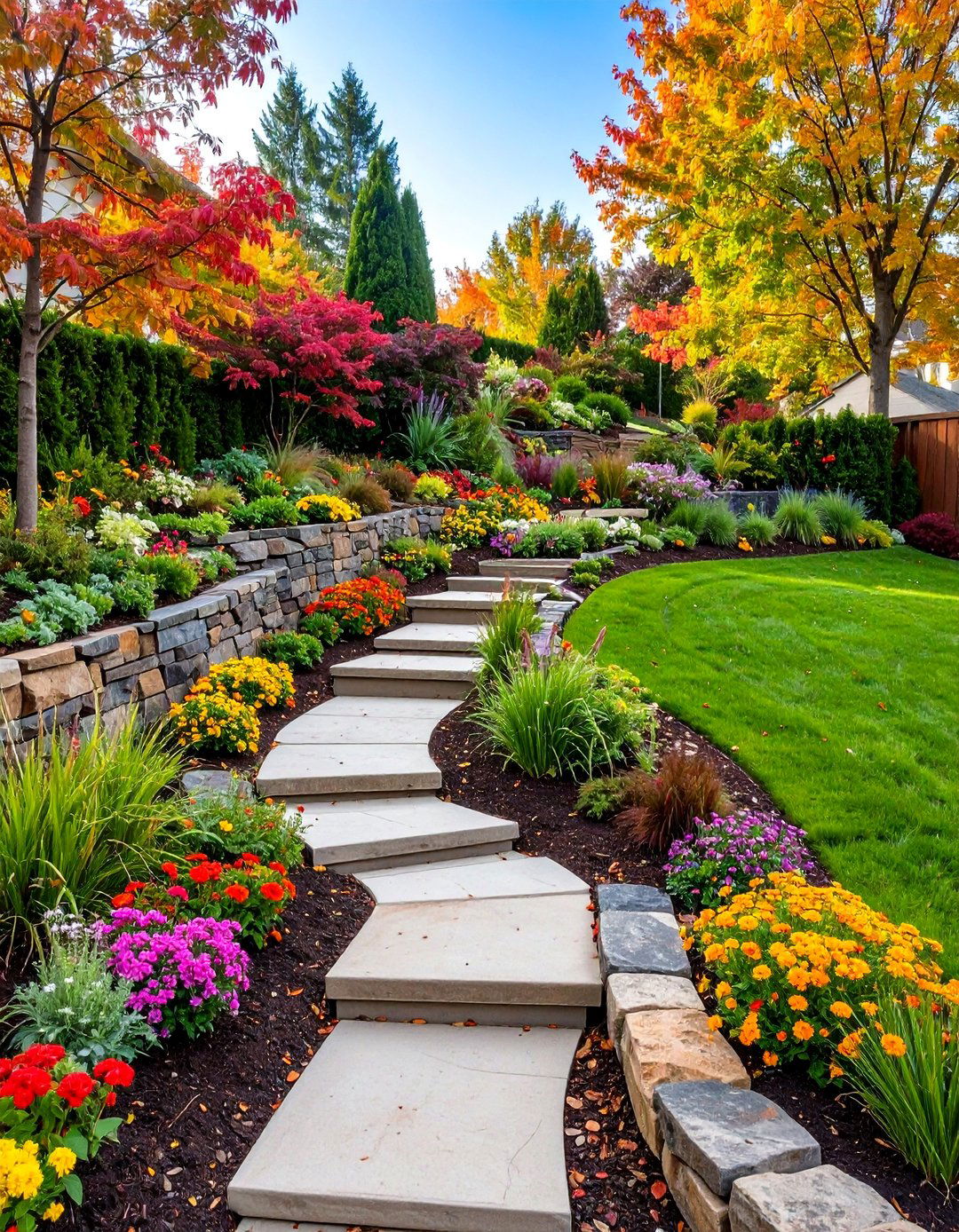
Creative solutions transform challenging sloped areas into attractive, functional landscapes through terracing, retaining walls, and appropriate plant selections. Terraced planting beds create level areas for easier maintenance while preventing soil erosion and managing water runoff effectively. Ground-covering plants like vinca, pachysandra, and ornamental grasses stabilize soil while providing attractive displays that require minimal maintenance once established. Stone or timber retaining walls create structure while providing opportunities for cascading plants and seasonal displays. Meandering pathways with steps or ramps provide safe access while creating interesting views and garden experiences. Strategic placement of drought-tolerant plants reduces watering needs on difficult-to-reach slopes while ensuring attractive appearances throughout seasons. This approach transforms potentially problematic areas into valuable landscape features while addressing practical concerns about erosion control and site drainage through beautiful, functional solutions.
25. Four-Season Interest Garden with Evergreen Structure
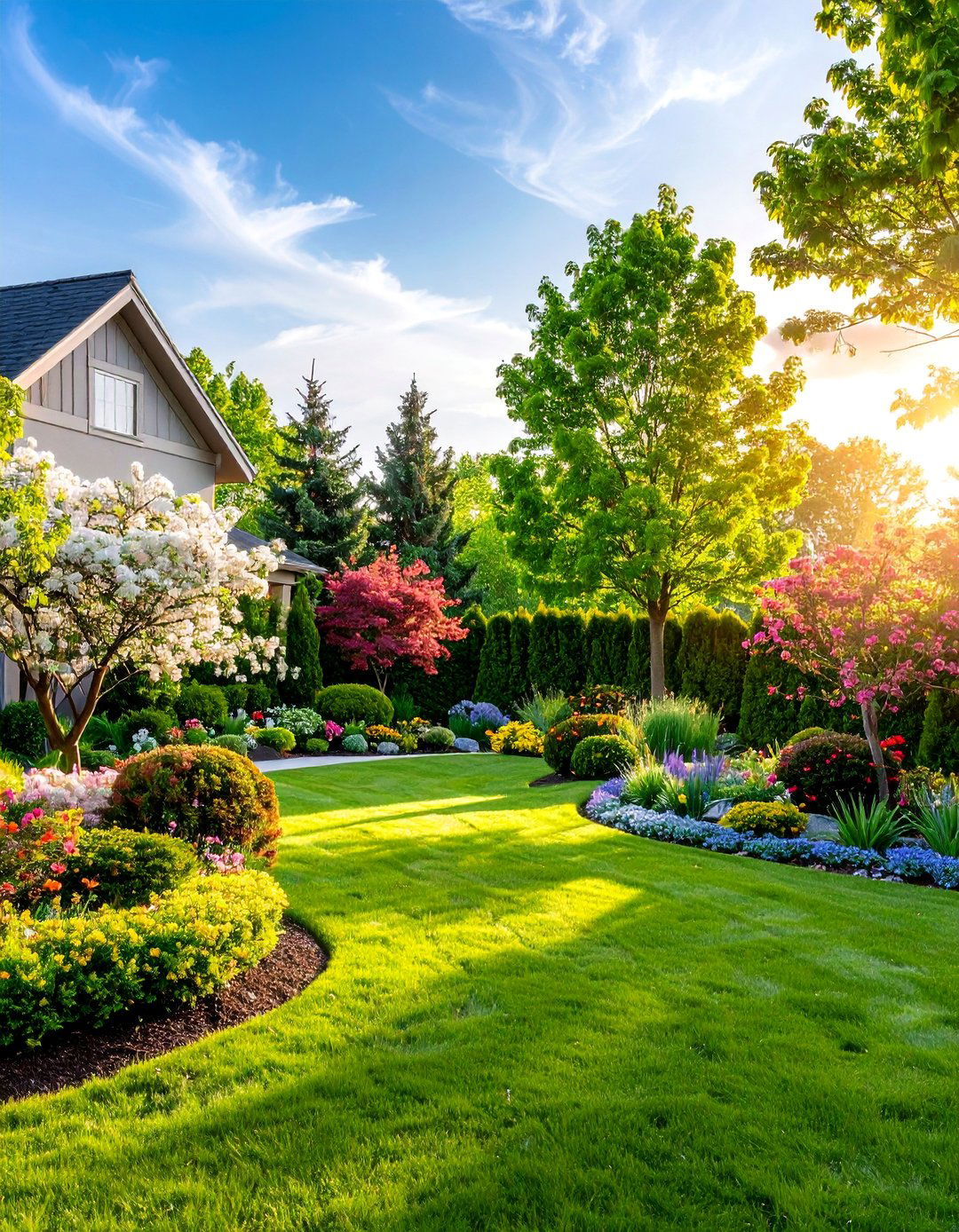
Year-round beauty drives this comprehensive approach that ensures attractive landscapes throughout all seasons and weather conditions. Evergreen trees and shrubs provide permanent structure and winter interest while serving as backdrops for seasonal displays throughout growing periods. Spring flowering trees like dogwood and redbud provide early color, followed by summer perennials and fall foliage displays from deciduous trees and shrubs. Winter interest comes from persistent berries, attractive bark, and ornamental grasses with lasting seed heads that provide food for wildlife. Strategic placement ensures continuous focal points and attractive views from indoor living spaces during times when outdoor activities decrease. This approach requires careful initial planning and selection of plants with multiple seasons of interest but provides excellent long-term value. The result creates landscapes that remain beautiful and engaging throughout entire years while supporting wildlife and providing outdoor enjoyment during all seasons and weather conditions.
Conclusion:
Successful front yard landscaping combines personal style preferences with practical considerations like climate, maintenance requirements, and architectural compatibility. Whether embracing modern minimalism, cottage charm, or sustainable xeriscaping, the key lies in selecting cohesive design themes that create lasting beauty while serving functional needs. These diverse approaches demonstrate that attractive front yards can accommodate various budgets, skill levels, and environmental conditions while significantly enhancing curb appeal and property values. By carefully considering plant selections, hardscaping materials, and overall design principles, homeowners can create welcoming outdoor spaces that reflect their personalities while providing years of enjoyment and increased home value through thoughtful landscape investments.


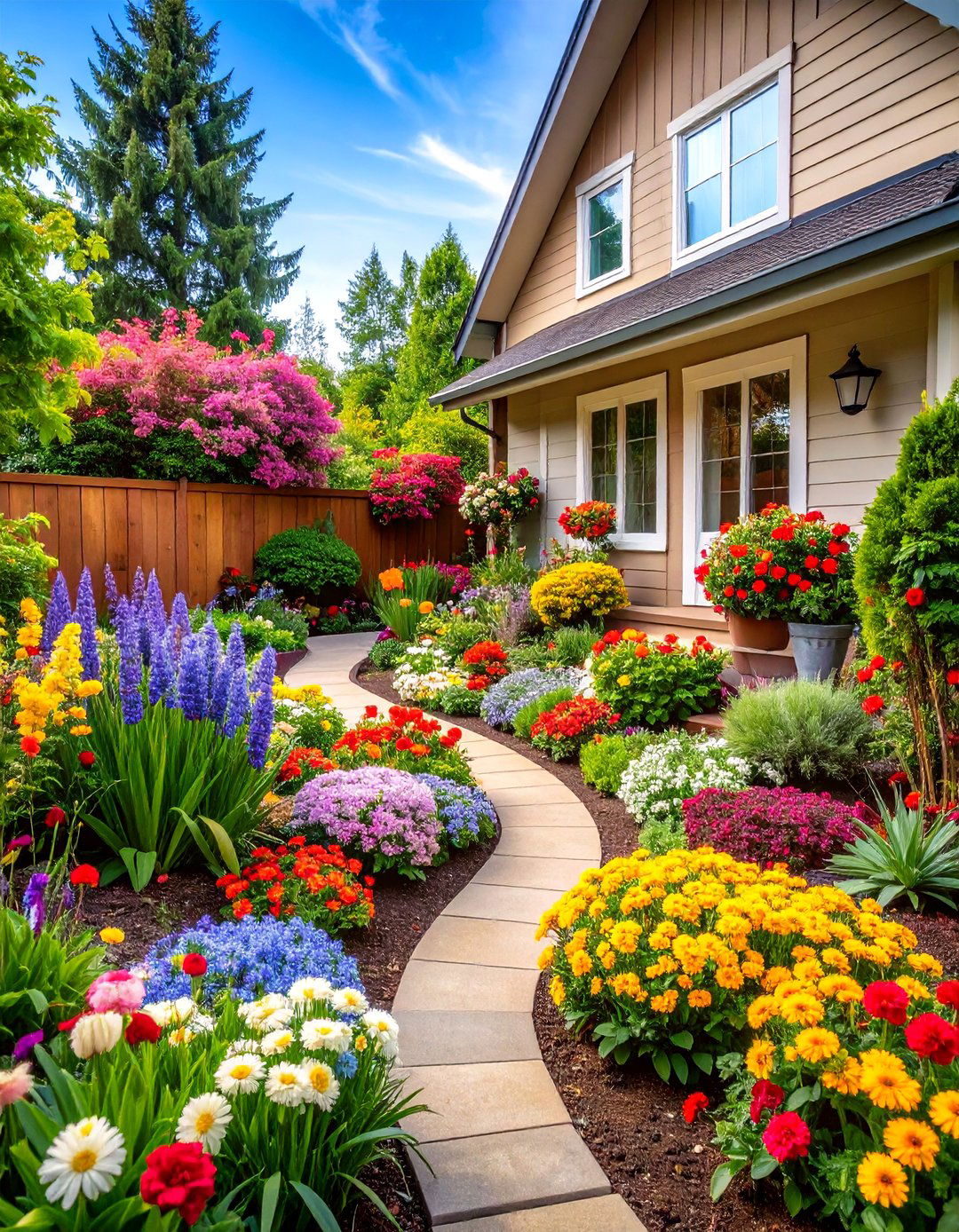




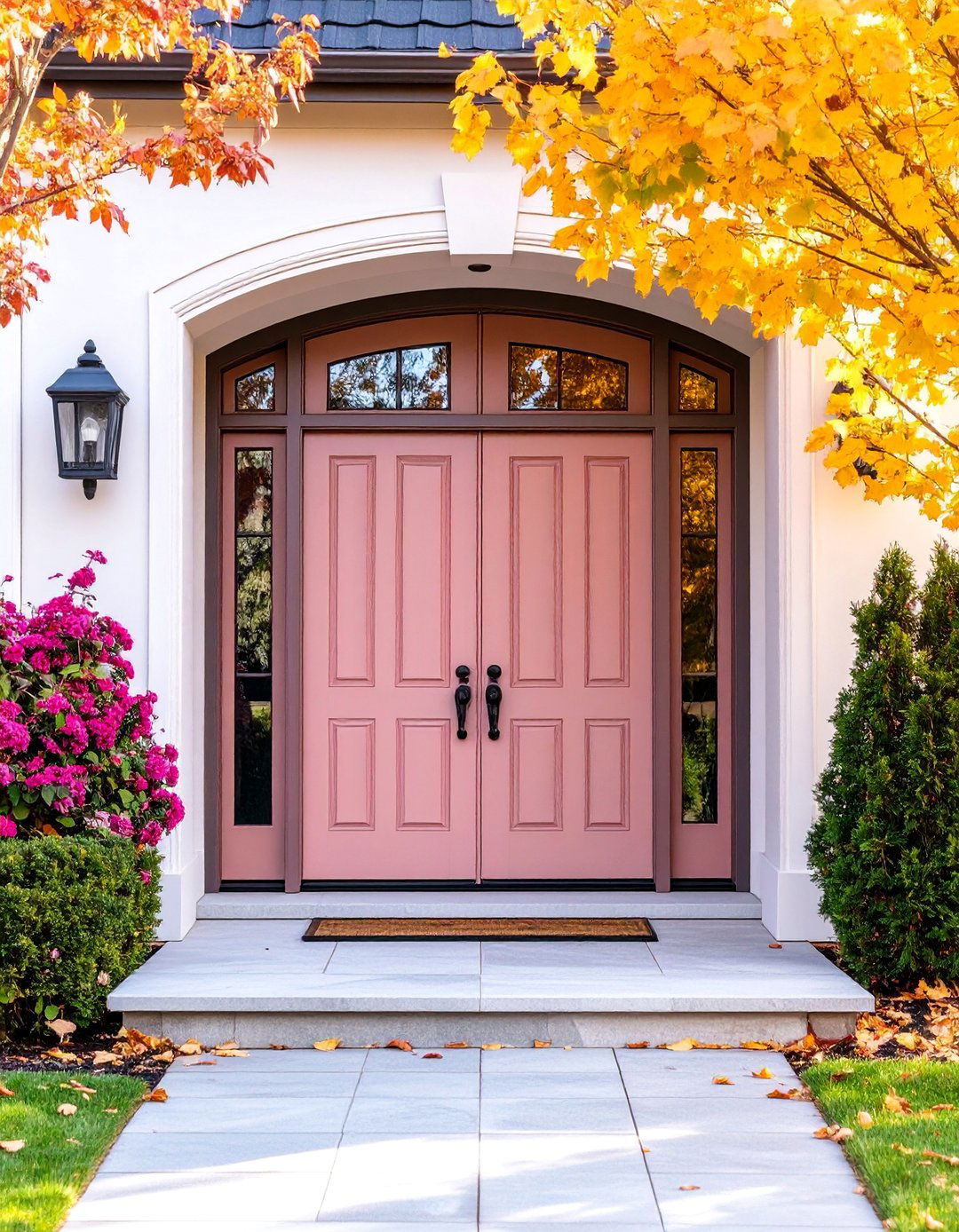


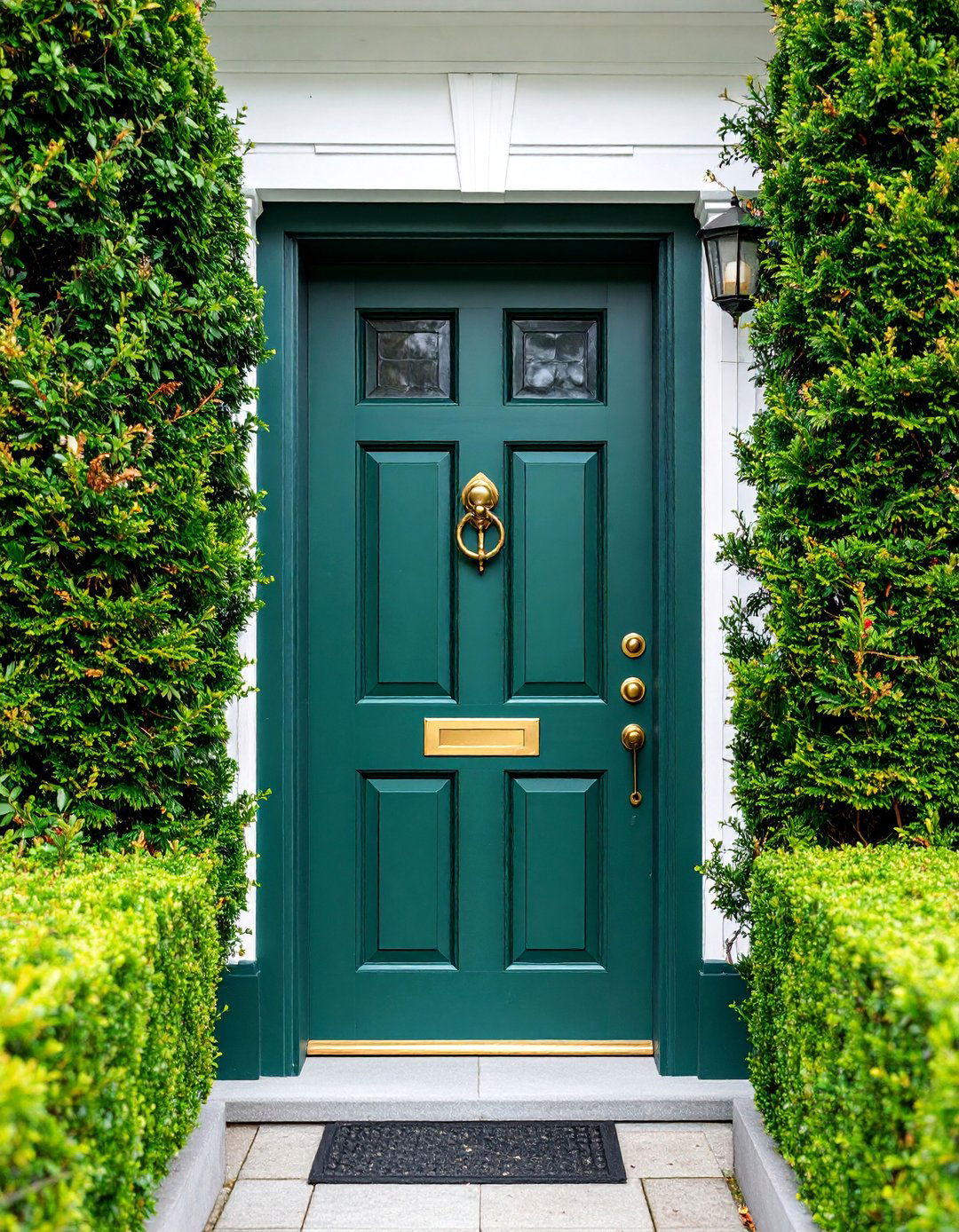
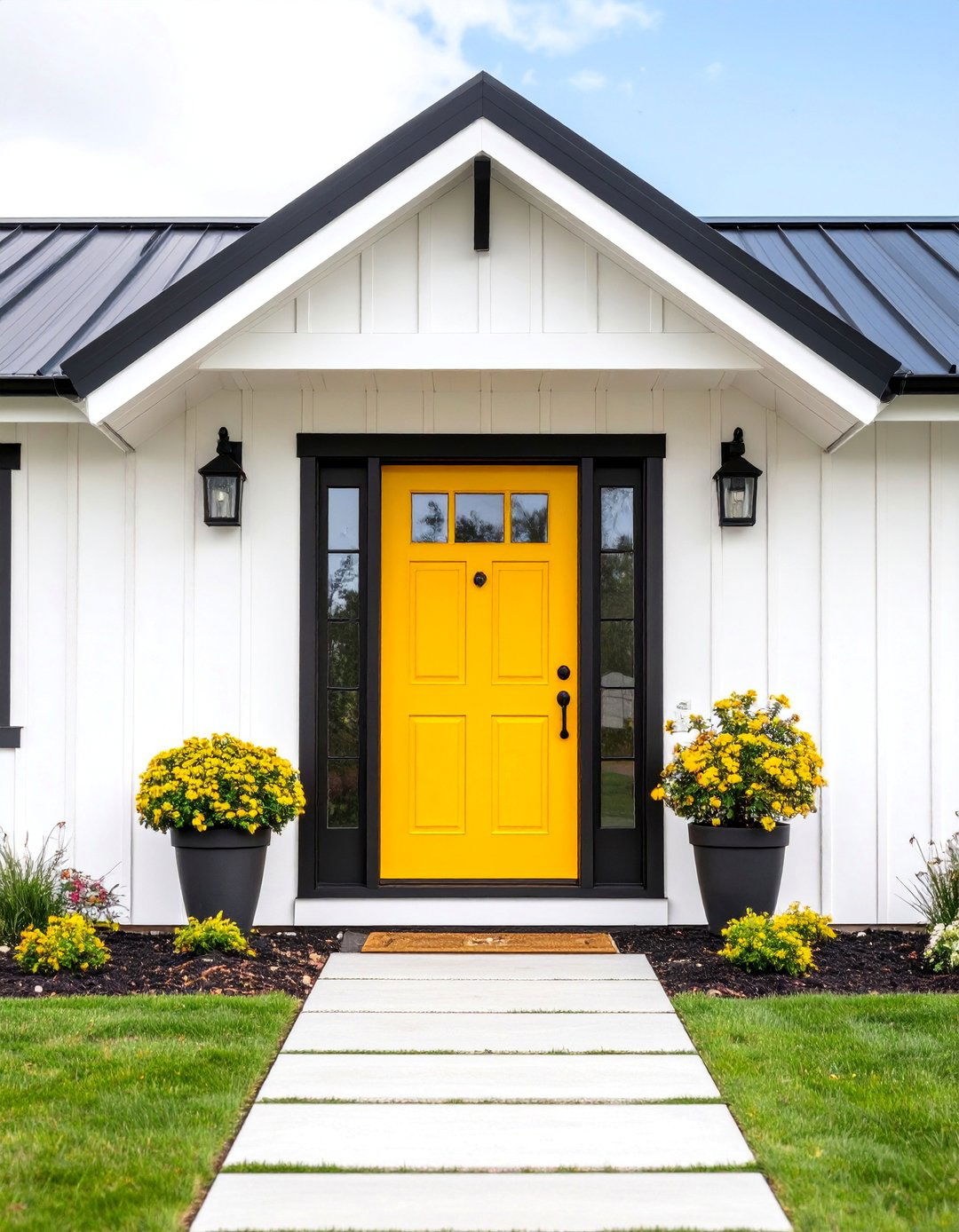
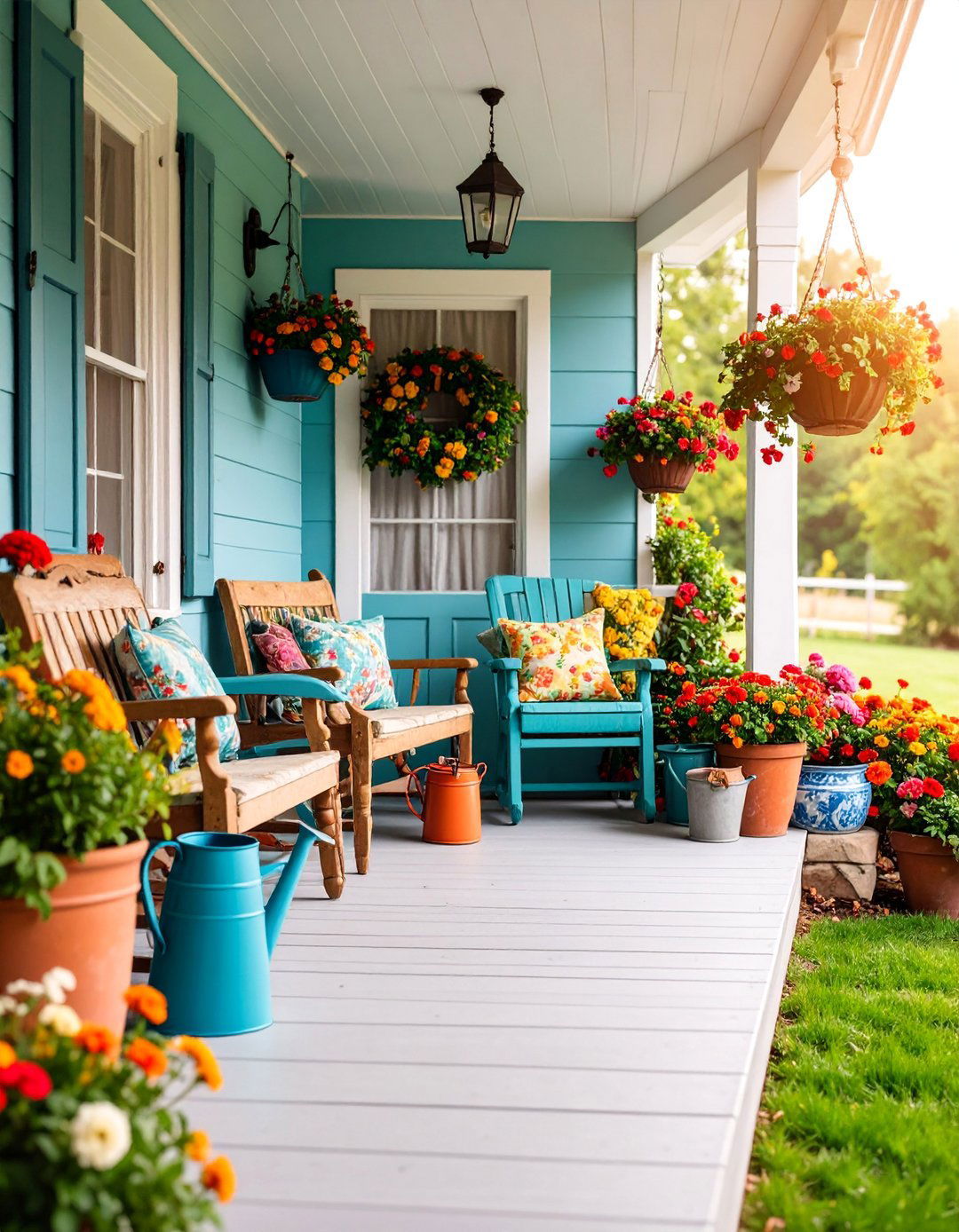
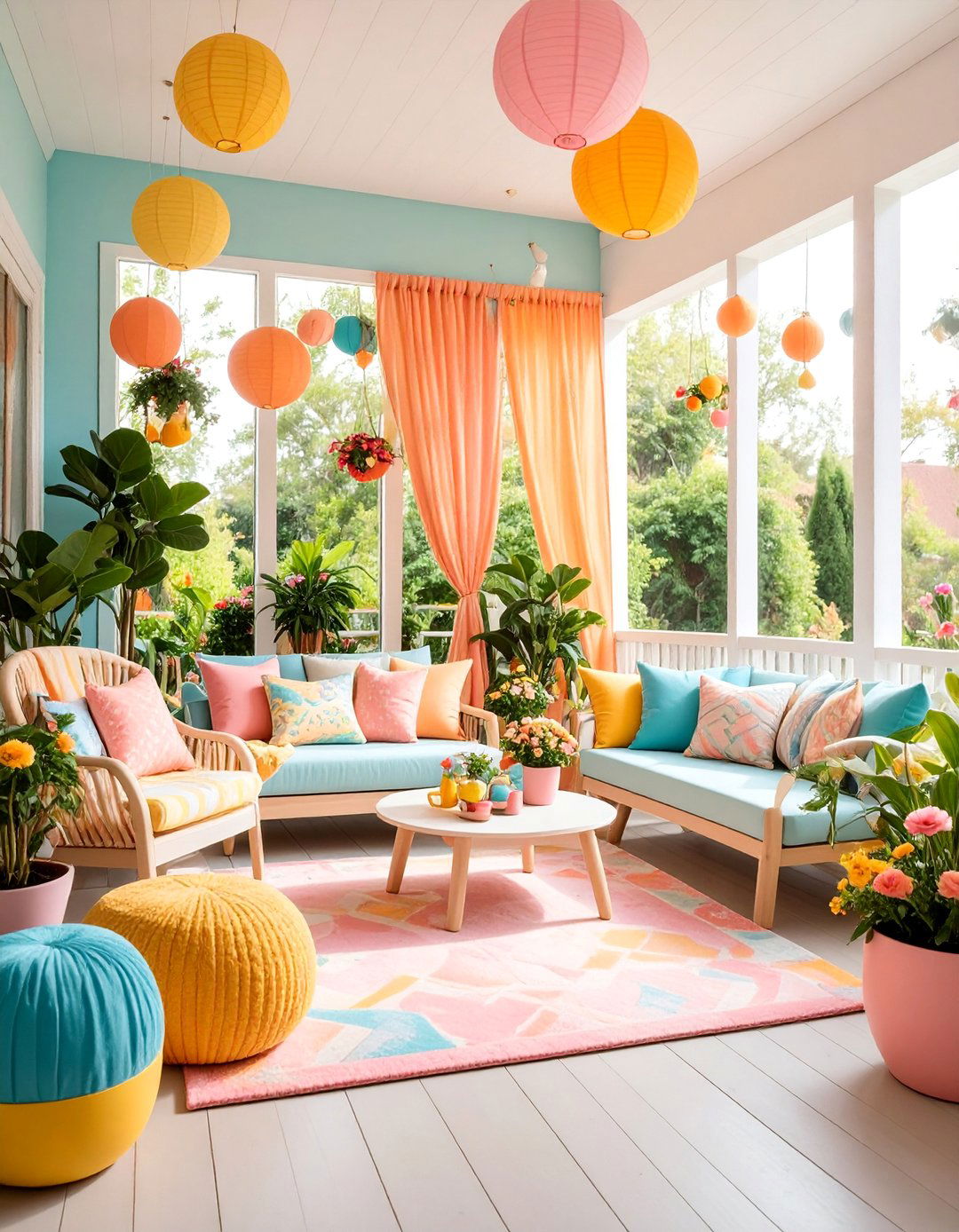

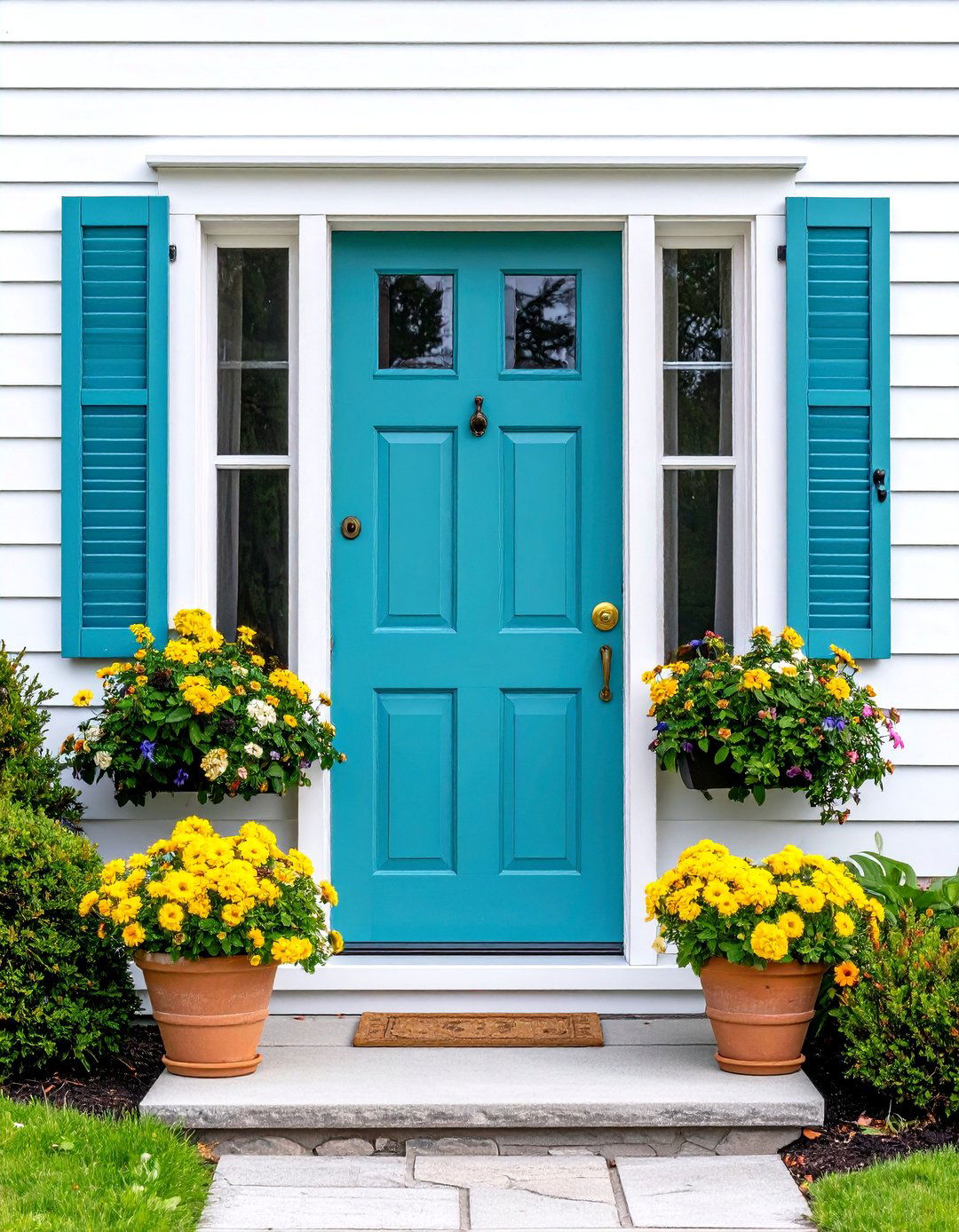
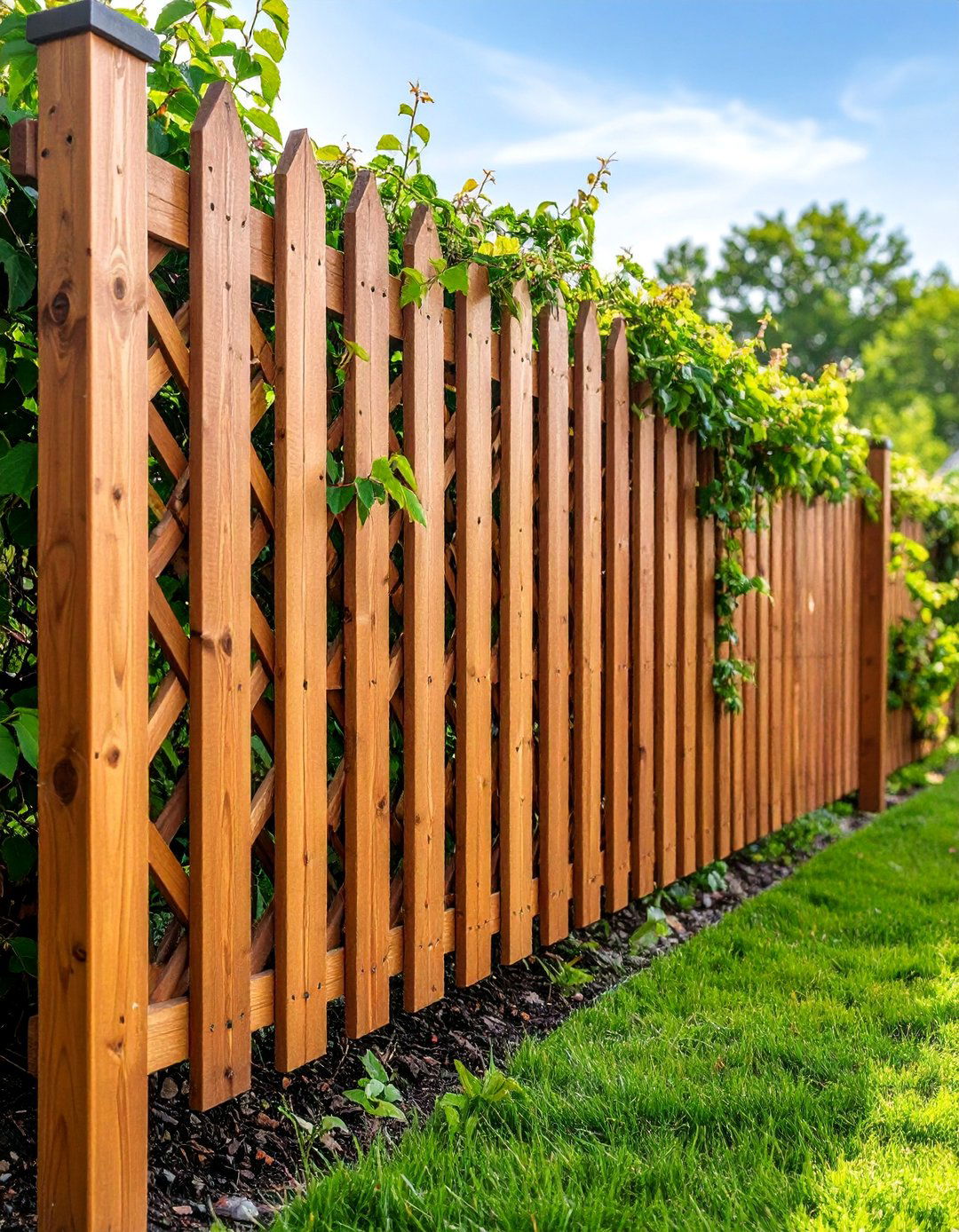
Leave a Reply